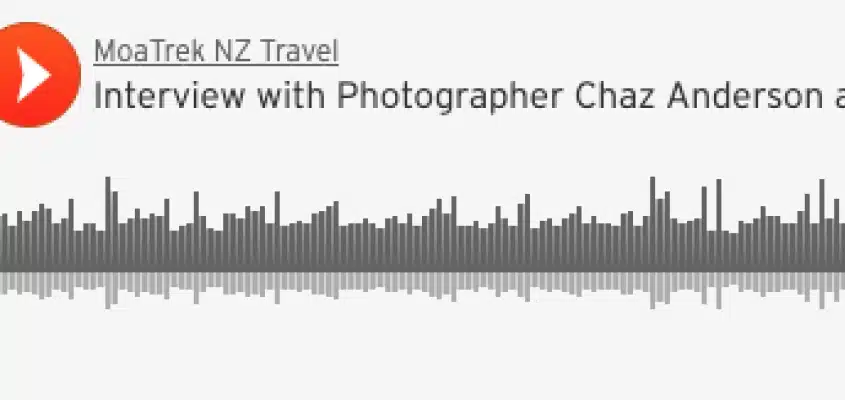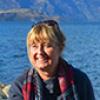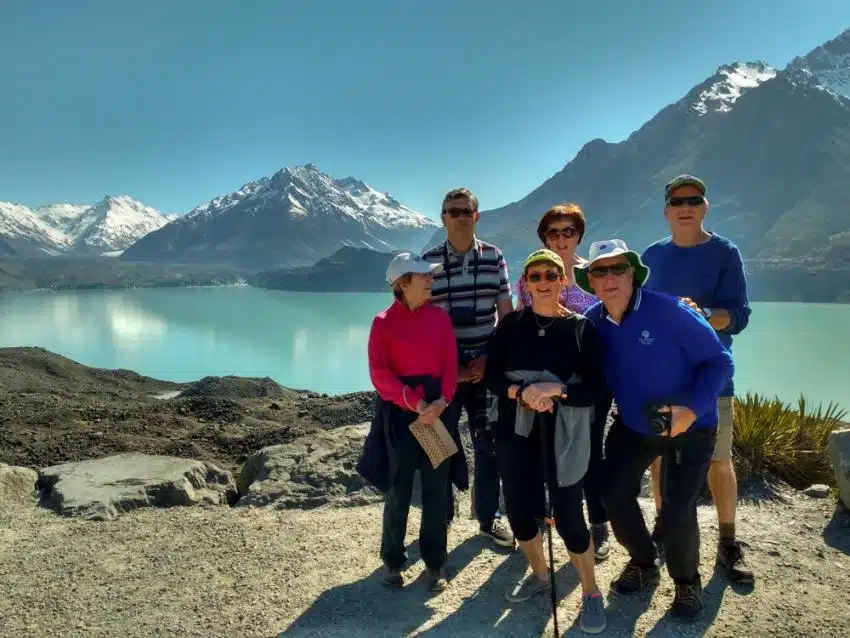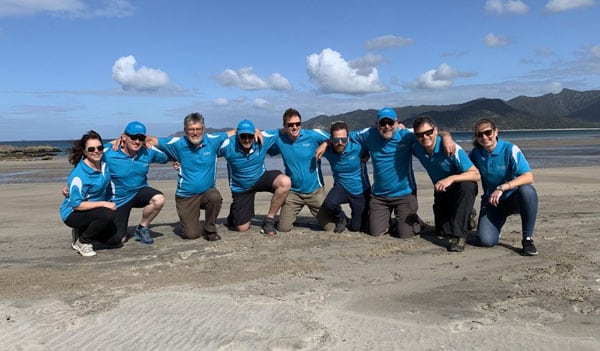American photographer Charles Anderson travelled around New Zealand in March & April in 2019 on a MoaTrek Small Group Tour and took hundreds of wonderful photographs all over the country. This is an audio interview with Charles in which he talks in depth about his trip from a photography perspective, he tells us the stories behind his favourite photos, shares his tips on what gear to bring and explains his techniques for getting photographs while being part of our Kakapo 21 Day North & South Island Tour.
The full interview is just over an hour and you can listen by clicking here on the SoundCloud file below. There’s also a full transcript of the interview here on this page below and we’ve inserted the pictures he’s talking about into the interview at the appropriate time so you can follow along.
Full Transcript of our Interview with Photographer Charles Anderson
Andrew: Kia Ora, everyone. This is Andrew from MoaTrek New Zealand Small Group Tours. Now today we’re trying something new. We have an audio interview with a recent tour guest Charles Anderson. Charles came out to visit us here in New Zealand, from his home in Virginia in the USA. Charles is a very keen amateur photographer and on his trip, he took hundreds and hundreds of amazing photographs that we all saw and were just so impressed with we had to talk to Charles. Charles was on our Kakapo 21 day North and South Island tour.
So we chat with Charles and we hear all about how he got all his photographs. He talks through the stories behind some of his favourite photographs from the trip, the gear he used, just tips what he did each day to get photographs. Lots and lots of handy information for anyone that would like to come out to New Zealand and take lots of photographs as part of their trip.
So now on the website, we’ll have a full transcript of the interview and lots of Charles’s photographs, and links to galleries. And a few more tips and resources for anyone who wants to take lots of great photos when they come out to New Zealand. So here’s the interview with Charles, it’s about an hour, we hope you enjoy it.
Andrew: So we’re talking with Chaz, who was our guest in New Zealand, with MoaTrek a little bit earlier in the year. First of all, Chaz, introduce yourself briefly, tell us where you’re from, and a bit about yourself.
Charles: My name is really Charles Anderson. I go by Chaz. I live in the state of Virginia, which is in the United States, it’s on the East Coast. I’m about maybe three-hour drive from Washington DC, which is south. I’m in the town called Colonial Williamsburg or Williamsburg, Virginia. It’s a very historic town. It goes back to the Revolutionary War.
Andrew: Oh, wow. And you were saying before a little bit about your background?
Charles: Well, I was an accountant for most of my career, but I was stationed in the U.S. Marine Corps for about six years. I was stationed at Marine Corps headquarters, which is in Arlington, Virginia near the Pentagon. And then when I got out of the Marine Corps, I was in accounting, mostly retail. I was the chief operating officer, or chief financial officer, in a number of different retail companies. And then my wife and I, at the time, my wife at the time, started her own business. We had an accounting firm for about 16 years before I retired about four years ago.
Andrew: Okay, great, great. Thanks. And you came and visited us in New Zealand just a couple of months ago, really wasn’t it? Can you tell us about that.
Charles: It was the tail end of March and the first part of April, I was there on your 21-day tour.
Andrew: Yes, that’s right. And can you tell us…we’d definitely love to hear all about that trip. First of all, why did you come to travel to New Zealand? Because the whole reason we’re talking is all these wonderful photographs that you’ve taken. So actually, before we do that, can I ask you tell us a bit about your photography background, please?
Charles: I’ve always been interested in photography, pretty much my whole adult career. I dabbled in photography. It wasn’t until I retired four years ago and I started traveling. I did a number of trips, crisscrossing the United States, couple of trips up to Maine. And then, of course, I planned my trip to New Zealand. I really got more interested in photography, the digital cameras were a lot better, and you were able to download them quickly to my iPad and things like that. And share my trips, mainly to share my trips with my son, who lives in Virginia, and my family and friends on Facebook.
So I needed a way that I could share almost daily emails with my son, and post pictures from time to time on Facebook, so people would know where I was. And I would post a couple of pictures every day and give them a little comment about where I was. People will get an idea of where I was from my travels across the United States.
Andrew: Yeah. And we’ll definitely…when we put this up on the website, we’ll put some of your photos and we’ll link to some of the galleries. Because as I said to you before that, you know, we’ve been looking at photographs of trips of New Zealand for many, many years. And none of them are really kind of made us go, “Wow,” like your ones did. So can you tell us then why you decided to come down to New Zealand, please?
Charles: Right. It had a lot to do with me retiring four years ago, trying to figure out…. you know, I closed… my wife and I, who’s now my ex-wife, we closed our business. And she wanted to move out of the States, my son still lives in Virginia. And I wanted to travel, I needed to find something to do that I found enjoyable. So traveling was one thing I always wanted to do. You know, we always took trips across United States but never spent a lot of time in certain areas in the national parks and such. So that started the whole adventure.
And then once I…kind of three years in doing that, I decided I needed to go overseas somewhere. My sister and my brother in law had traveled to Ireland, a lot of my friends have been to Ireland, Great Britain, Germany, and I wanted to go somewhere where they hadn’t been. And somewhere that I thought would be an interesting place to take pictures. And I always had this desire to visit New Zealand. I didn’t really know a lot about New Zealand.
So I bought myself a travel book, I bought myself a good map. And then when I got online and looked at MoaTrek’s itinerary, I really became more fascinated that this would be an ideal trip for me. A small tour trip that I didn’t…I’m a solo traveler. And it had a lot of built-in options and free time that was gonna be beneficial to really what I wanted to do and would benefit and complement my type of photography.
Andrew: Here’s a question for you. Can you remember maybe not the first photograph you ever saw of New Zealand, but is there a photograph of New Zealand you know, when you started researching your trip? Is there a photograph of New Zealand that still sticks in your mind or that you recall?
Charles: Well, I think I looked at quite a few pictures on your website. And most of those were tourists type pictures, group pictures, which were interesting to me. But I did a lot of I guess not Facebook, but YouTube videos to get an idea what the countryside really looked like. And of course, I had brought my travel book, which is very good travel book. And just looking and researching. I’m kind of a little bit of a guy that likes to get on Google and go down the rabbit hole. And I did a little bit more research and saw some you know, wonderful pictures that other people had taken. And I got more interested in that idea of going to New Zealand then.
Andrew: Are there any places that you remember seeing early on, and do you remember thinking, “Oh, wow, I’d really love to take photographs there.”?
Charles: Oh, kinda, this is what I did. I have my travel book, I had my map, I have your itinerary, which you’d detailed all the stops and all the places that we were going to visit. And I did a lot of reading. And I did a lot of cross-referencing. And I have a logbook or a book that I wrote notes in and I said, “Well, if we go to Auckland or we go to Wellington or we’re gonna go to North Island.” What kind of places did I wanna see, what kind of places that maybe I could branch off from the tour on my option days and explore other areas.
And I think my photographs kinda illustrate that to some extent that I do like to wander off and to be on my own and see things that are interesting to me. I like museums, I like art galleries. I like meeting people. We had a great group on our tour. Obviously, Paul was a great tour guide. But I really enjoyed my time in some of the cities, Wellington, Christchurch, Auckland, because they gave me more opportunity to do a little bit more of my street photography, which I enjoy doing also.
Scroll through some of Chaz’s pictures of his MoaTrek travel companions
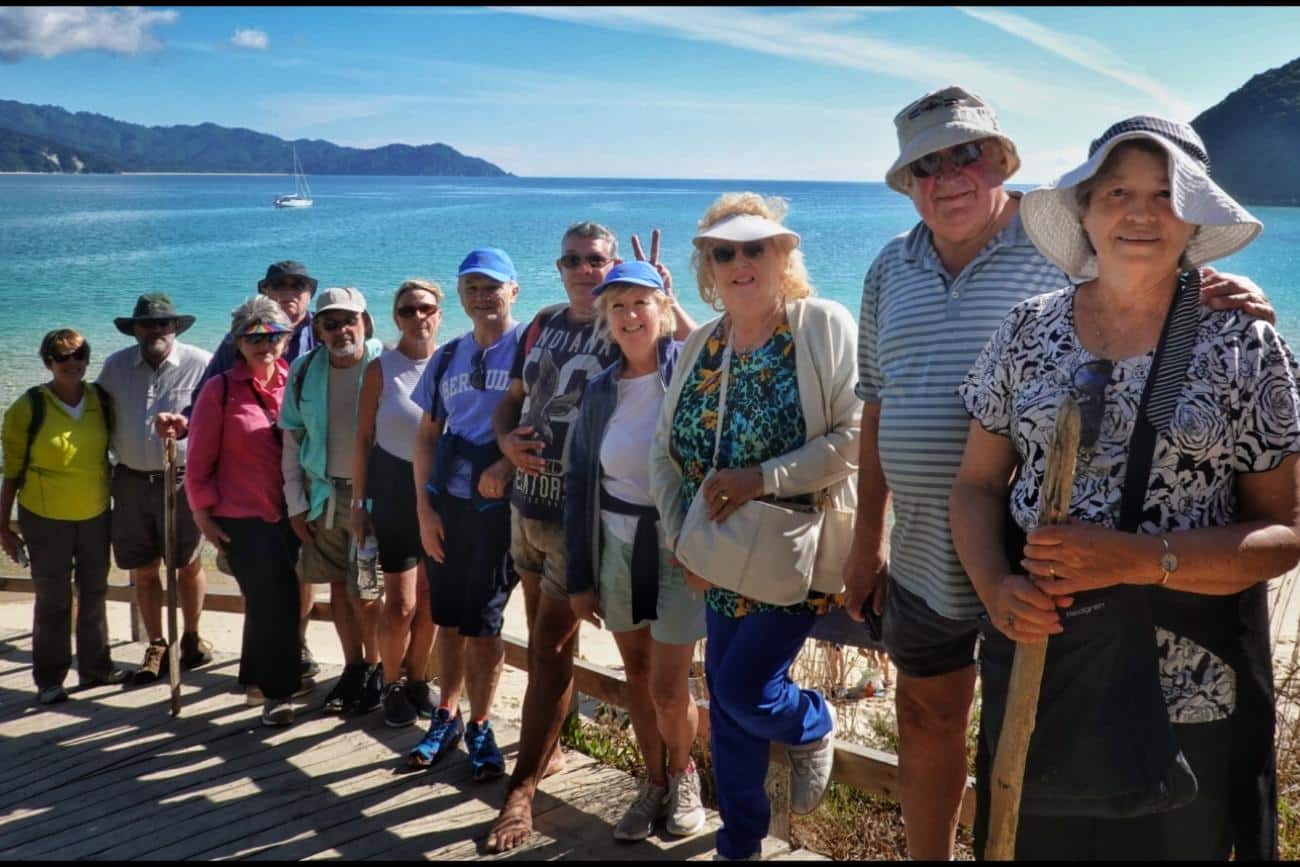
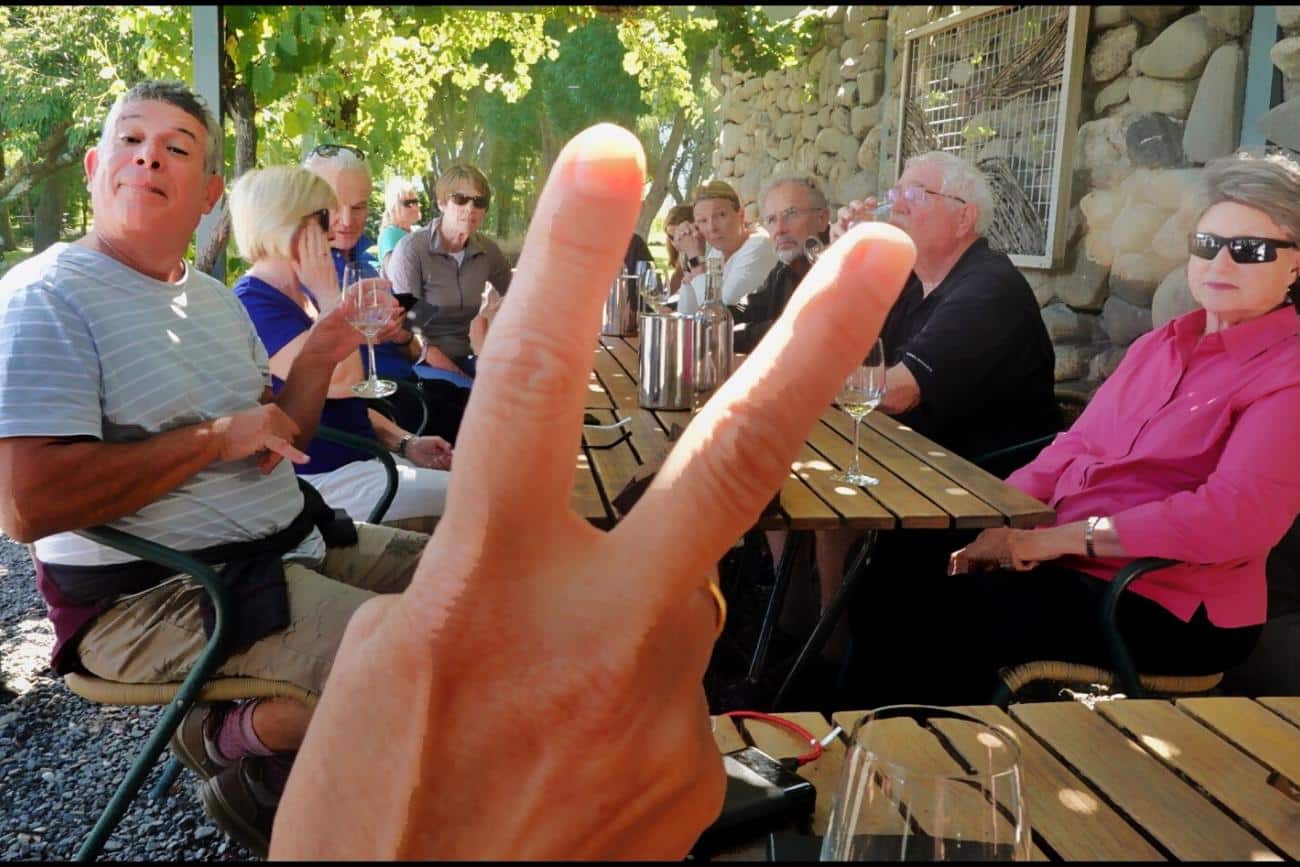
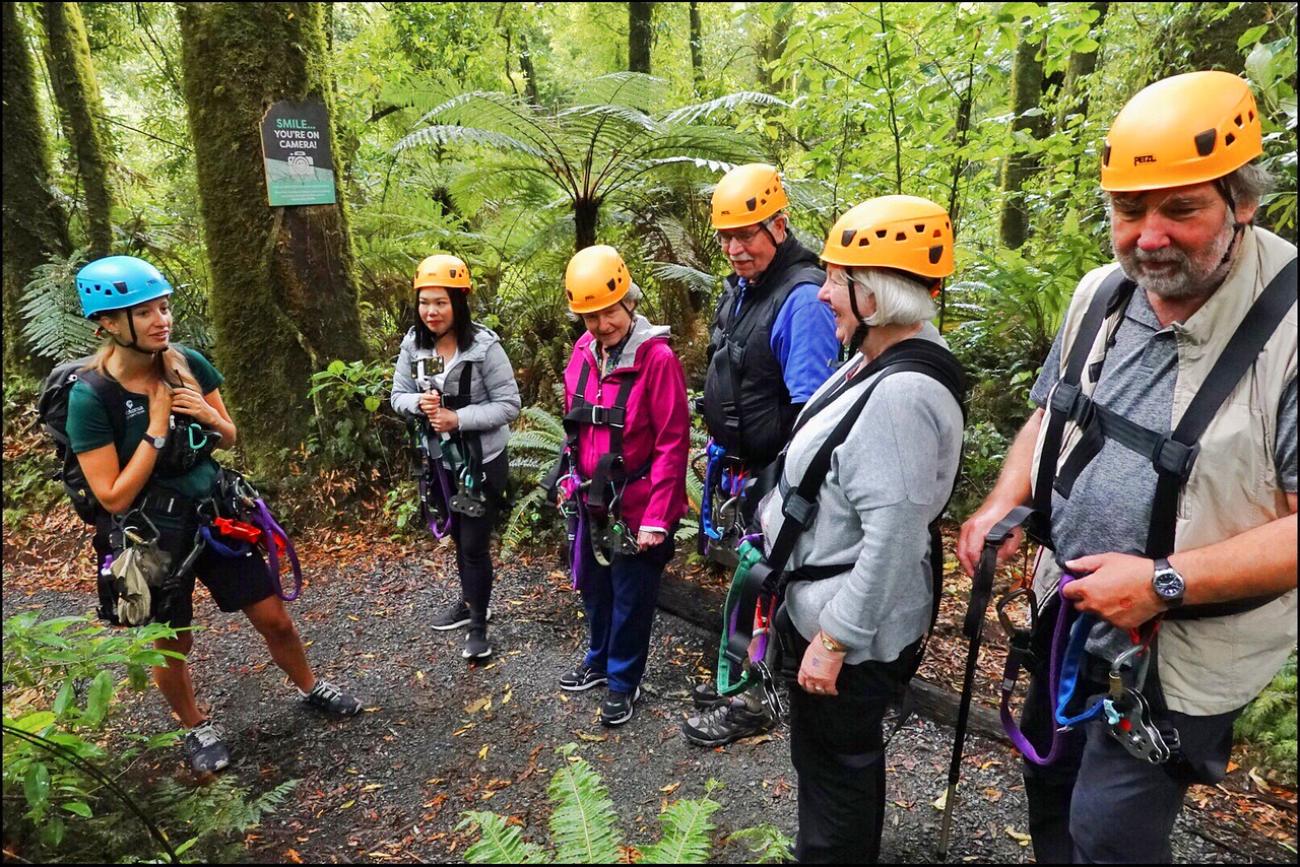
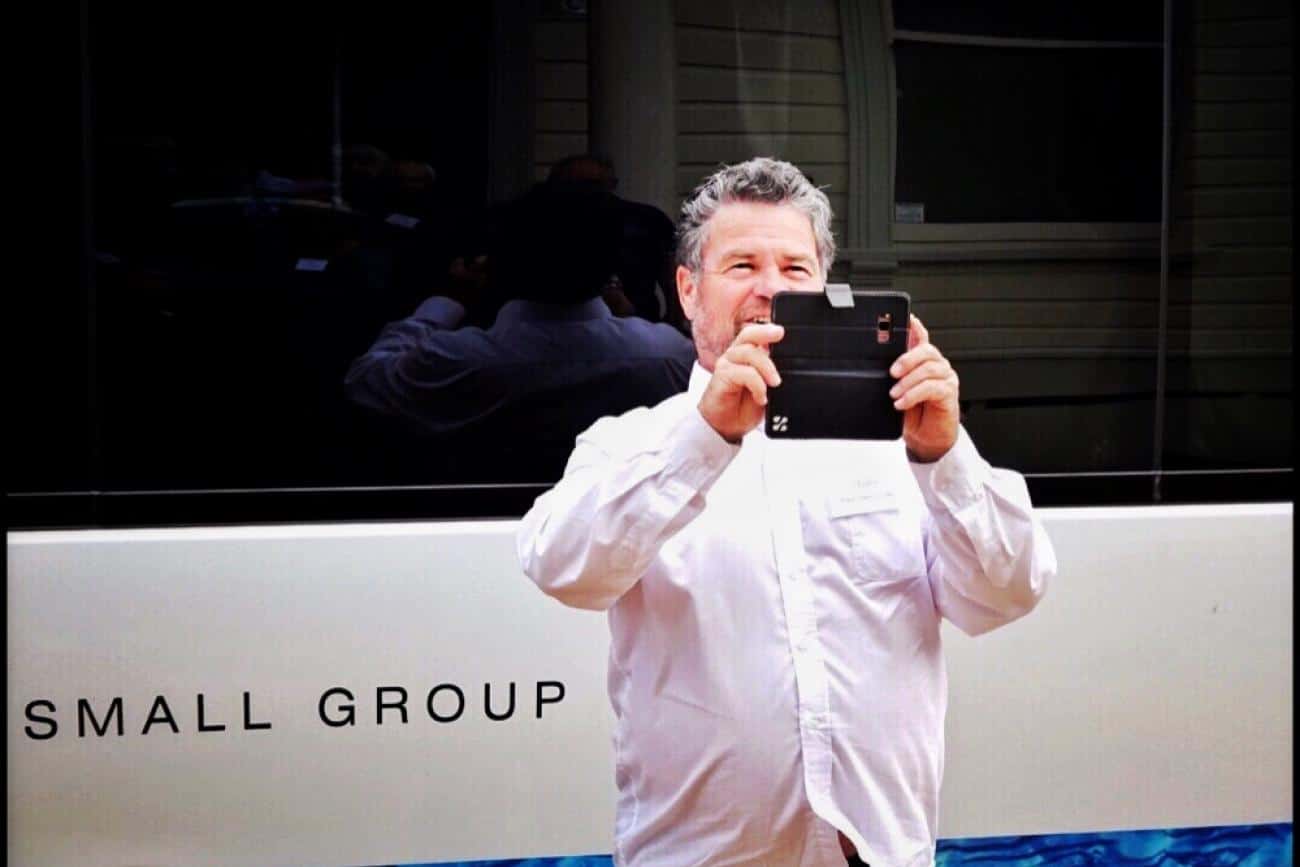
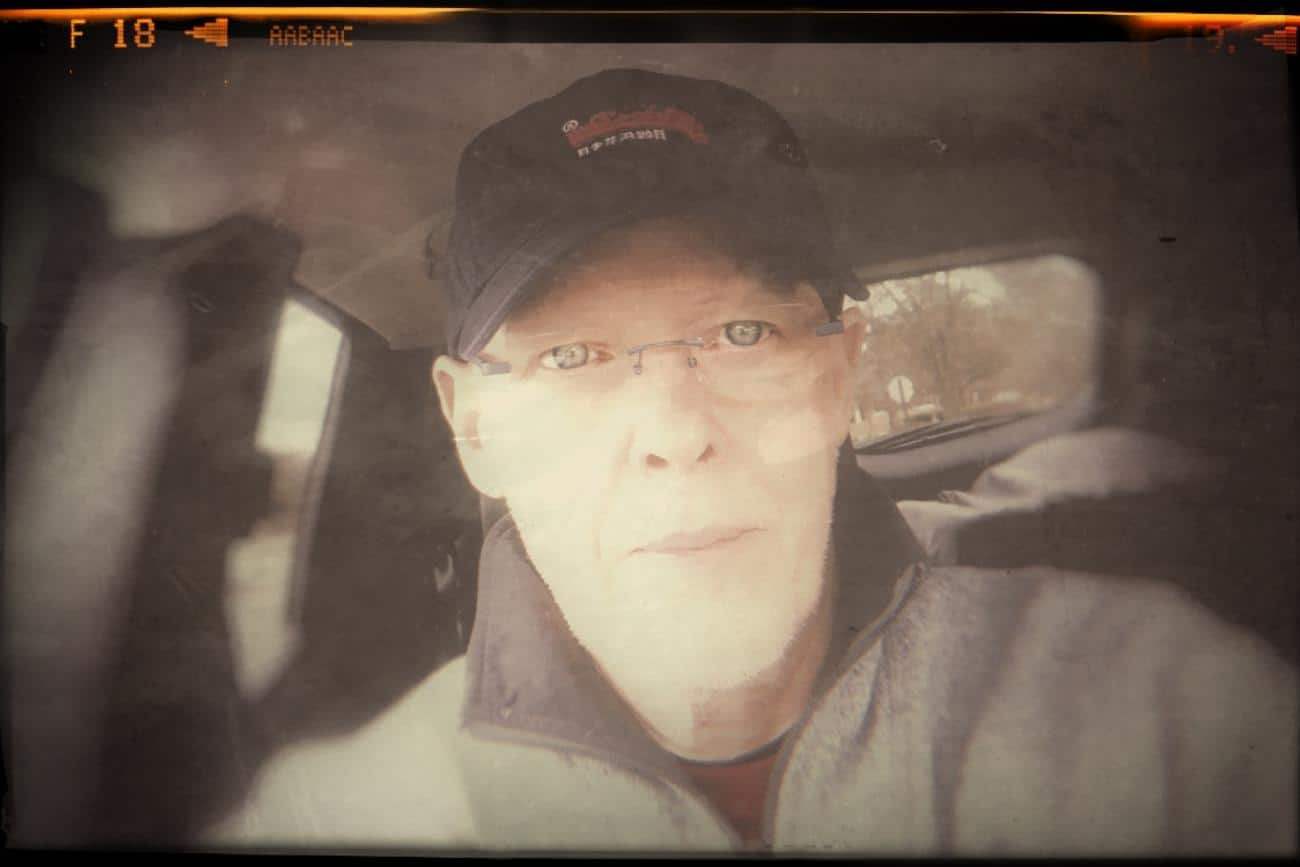
Andrew: Now, as I said, we’ll definitely put some photos up there. You obviously like taking photographs of people as well.
Charles: Well, I consider myself an introvert that’s converted to an extrovert. I can kind of use photography as a way to work my way into talking to people, it brings me out of my shell a little bit. I see somebody that’s interesting. You know, I can give you a few examples. But I walk up to them, I introduce myself, I have a bunch of business cards that I hand out to people that has my name and my contact information. And one of my photographs on one side, and my reference to my blog. And I say, “Hey…” A lot of times I tell them I take pictures for Google Maps, which I do as a hobby. And that kind of breaks the ice.
I found that people in New Zealand a ittle bit more reserved. They don’t like people sticking cameras in their faces. But if you kind of hold the camera at your side, and kind of introduce yourself first. Once you kind of break that introduction, they open up to you. I was able to ask a lot of people a little bit about themselves, and then eventually ask them if I could take their picture. A lot of times I would talk to people not even ask to take their picture because I found it more interesting than it was actually taking their picture.
Andrew: Yeah. We’ll go and talk about some of those photos in just a second. But I wanted to ask one question. Before you came or, you know, when you came to New Zealand, did you have a specific kind of photography goal in mind? Or an end product in mind? What were your thoughts around there?
Charles: What I found that…based on my travels in the United States the kind of pictures I take, I take a lot of different type of pictures. I do landscape, I do street photography, I take pictures of interesting things that I find interesting to me. And my goal has always been to be able to share with my son and to share that with my family and friends on Facebook. So that was always my goal to kind of tell my story. A little bit about my story and my travels, that people would find interesting, rather than just sending a bunch of pictures and not saying anything about what it was.
So I’ll usually put a little description that went along with the photo when I was sending an email to my son, which he enjoyed. He’s very good about emailing me right back. He would then, in turn, share that with his girlfriend, and then, in turn, share that with his mother, my first wife. So it was always kind of interesting to get his feedback and let him know what I was up to, what we were doing on the tour and where were we going next. And some of the things that I found interesting. If you kinda look at my photos as a whole, some of my galleries, I kind of got into this where I’m not just taking pictures and throwing them up on a gallery, kind of putting a theme together a little bit, maybe tell a little bit of a story.
Andrew: Yeah, I can definitely see that. Okay, excellent. So let’s have a look at some photos. And as I said that you sent me some photos yesterday, and I have actually looked through all of your photos multiple times.
Charles: All close to 900 photos, those are just the photos posted on my blog. I mean I took a lot more pictures, but most of them were not very good.
Andrew: That’s the way isn’t it? Take 1,000 and get 100 keepers. And you sent me I think half a dozen, four or five yesterday. Do you want to tell us about a couple of those? Like…
Charles: If you look at the one picture of Auckland.
Andrew: Yes, I’ve got that one. And we’ll put that on the page.
Chaz’s favourite Auckland photo – the Wynyard Quarter
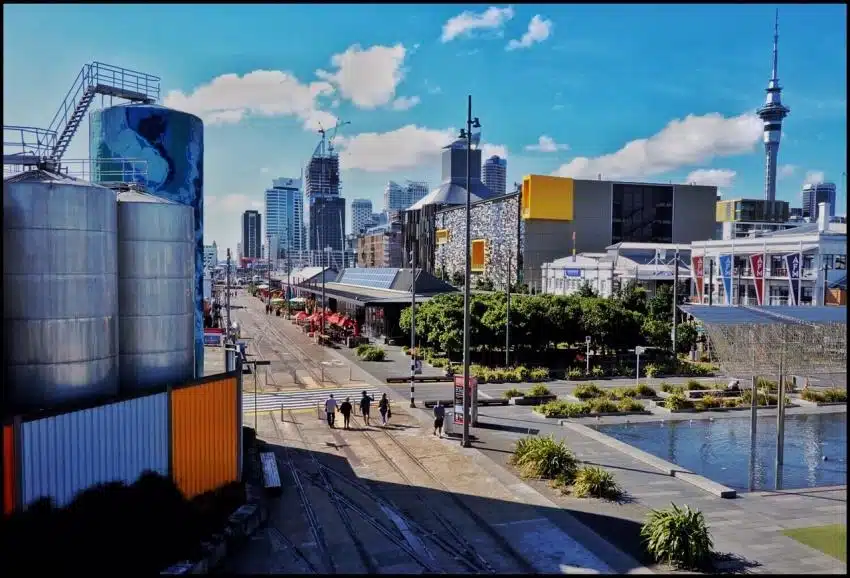
Charles: I was very pleased that I added a couple of days to my tour at the beginning. And I had a couple of days that I added at the end when I was in Christchurch. So I added almost four days. And being able to arrive in Auckland early in the morning gave me an extra day. And then we had a built-in layover in Auckland so Paul could have a day off. So I ended up with about four or five days in Auckland which I found very interesting. Being your largest city was very cosmopolitan to me, the people were very unique. It was easy for me to get around. Our hotel was near the harbor.
But I love to walk and I walked down this… Oh, I guess it used to be a train track it went into some silos and they had restaurants along there. Was border to the harbor there on both sides and near the harbor. So it was an easy walk. I think I must have made that walk maybe three or four times.
Andrew: Yes. It’s called the Wynyard Quarter that area.
Charles: And that area towards the end, they had an elevated platform almost like the outline of a building or shed or warehouse and you could you climb up the steps. And I obviously gave you a much higher view. I must say the weather was very nice when I was there. So I got this great shot looking into the city, see the skyline there. You actually see people walking in some of those very colourful I guess they were gas tanks or petrol tanks that people had painted. So I thought that was very nice. I thought the picture came out really good.
Andrew: I’m looking at it right now. I love that. I know exactly the point you mean, it’s a great little walk down on the waterfront there across that bridge. And over to that, it’s called Wynyard Quarter. It’s kind of one of the newer part of the waterfront in Auckland.
Charles: And there was a lot of things going on there. There were restaurants, the area was very clean. It was a very enjoyable trip that I guess I made about three or four times. I took a couple of night pictures there too so it was very enjoyable for me.
Andrew: Yeah. And there’s a photograph… I’m pretty sure it’s Auckland of… I think it’s the Winter Garden in the Auckland domain?
Chaz’s Auckland Winter Garden Photo – the Mysterious Woman
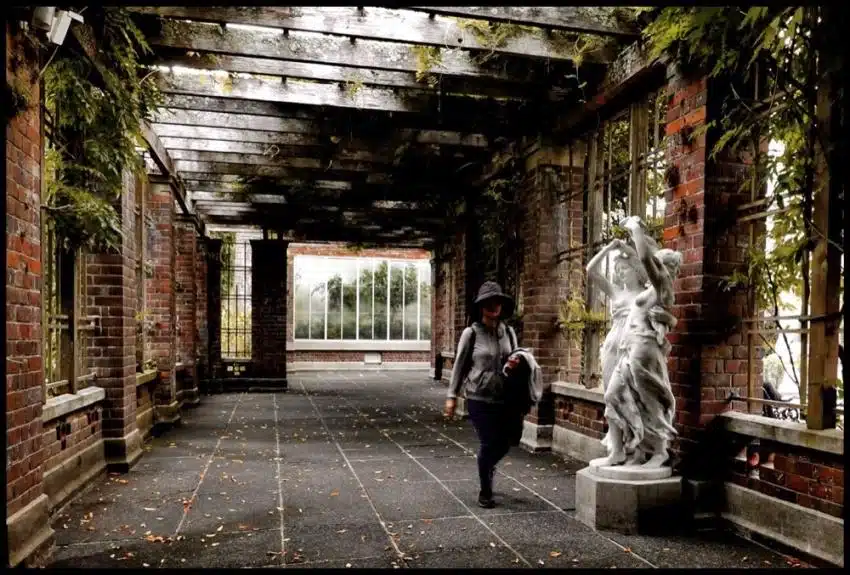
Charles: Yes, that was taken in the Winter Garden. I had walked up there from my hotel which is up the hill. And I was gonna go to the museum that’s past Winter Garden. So I went into Winter Garden and this was a walkway around part of the garden there. And I was interested in that [inaudible 00:16:43]. I guess that’s what you call it and the vines growing on the brick. And I kept looking and trying to compose a picture and it wasn’t quite working very well for me. So I kind of stood back awhile and this woman came walking around the corner and walked towards me. A lot of times people will stop and they’ll say “Excuse me I’m in your picture.” Or say “Don’t take my picture.”
But she kept walking towards me. And I just got her I think at the right time. Her look you can’t see her face there’s a lot of shadows going on there, and those white statues of two female women and all the background. It really came out… I thought the picture came out one of my best, and I think was one of my favorite shots I took in New Zealand. And the funny thing about it is she kept on walking, she didn’t say anything to me, I didn’t say anything to her, she just kept walking past me. So it turned out to be I think a pretty interesting shot.
Andrew: Yeah, no, I’m looking at it right now. I know that spot in the Winter Garden. And that’s right up near the museum. And you also get really beautiful views of the whole Auckland the Hauraki Gulf, the islands from up the top there, don’t you?
Charles: Yes, it was a beautiful… I spent the better part of a half a day up there. Had a nice lunch and did a lot of the Winter Gardens and then went to the museum and spent some time looking at the history of New Zealand at the museum. Of course, we had a great view because you’re up way high on the hill. It’s interesting the pitch too where they play cricket.
Andrew: Yes, cricket is always a funny one when we see…when we pass by a cricket pitch with visitors from America it’s always a funny one. There are similarities to baseball but not all, not exactly the same. And you’ve got a photo here from Queenstown, and you know, a lot of people kind of know the name Queenstown and there’s a lot of photographs of Queenstown. Can tell us about this photograph down by the lake in Queenstown, and any others around Queenstown that you took and how that was for photography?
Chaz’s favourite Queenstown photo – Lake Wakatipu
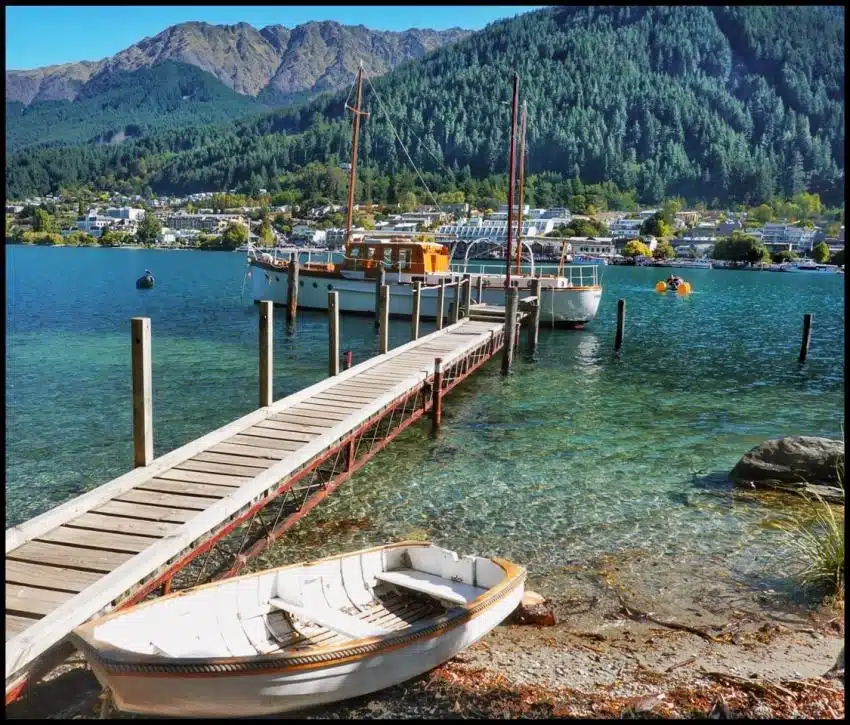
Charles: Yeah, our hotel was really close to downtown Queenstown what you see in the background in this picture. Of course, the lake was right there. And on the other side, there was quite a few restaurants and boats, some people could take out cruises. But this side of the lake was also a botanical garden. I think they had some tennis courts, some bowling greens, places to picnic, waterways and things like this.
So I saw that I could walk around the whole botanical gardens, and pretty much to my left the whole time would be water, and to my right would be greenery. So I said, “Well, this would be an interesting place to go take some pictures.” I am fascinated with water, kayak, I’ve sailed before. My in-laws had sailboats so I’ve been around sailboats a lot so when I came up, this was right off the trail when I was walking. I always had my camera in my hand, always looking for various interesting things to take pictures of.
And the water, of course, was a very beautiful sky that day. So it must have been maybe 10:00, maybe 10:30 in the morning, and it wasn’t too hot. It was very beautiful. And I saw this dock, the little dingy there and a sailboat in the background. And if you look really hard there were two little kids, they were on a paddle contraption of some sort. I took another picture closer on the other side, they were having a great time paddling back and forth out there. So I kind of got them in the picture too. But amazingly enough, quite a few people that I sent this picture to really enjoyed this picture and thought it was a pretty nice photo.
Andrew: Yeah, there’s always something about boats and pictures that kind of just give it that sense of, you know, a journey or, some kind of untold stories in the background, isn’t there?
Charles: Yeah, the different shades of the water really, and the how clear the water was, and how beautiful the background there with the mountains kind of gives you a good sense about what you…if you’re going to visit Queensland what you’re getting yourself into.
Andrew: Now, you’ve got a few pictures in here of people. Is there of those one of those of those that you sent me, is there one of those that there’s a story behind which you remember well?
Charles: Well, I remember all the stories. Two of the…the one picture of the group, they look like they’re musicians. Three men, a guy has a guitar and one woman she’s kind of standing there in the middle. I was walking… is it Queen Street?
Scroll through Chaz’s favourite street photos of Sophie and friends on Queen Street
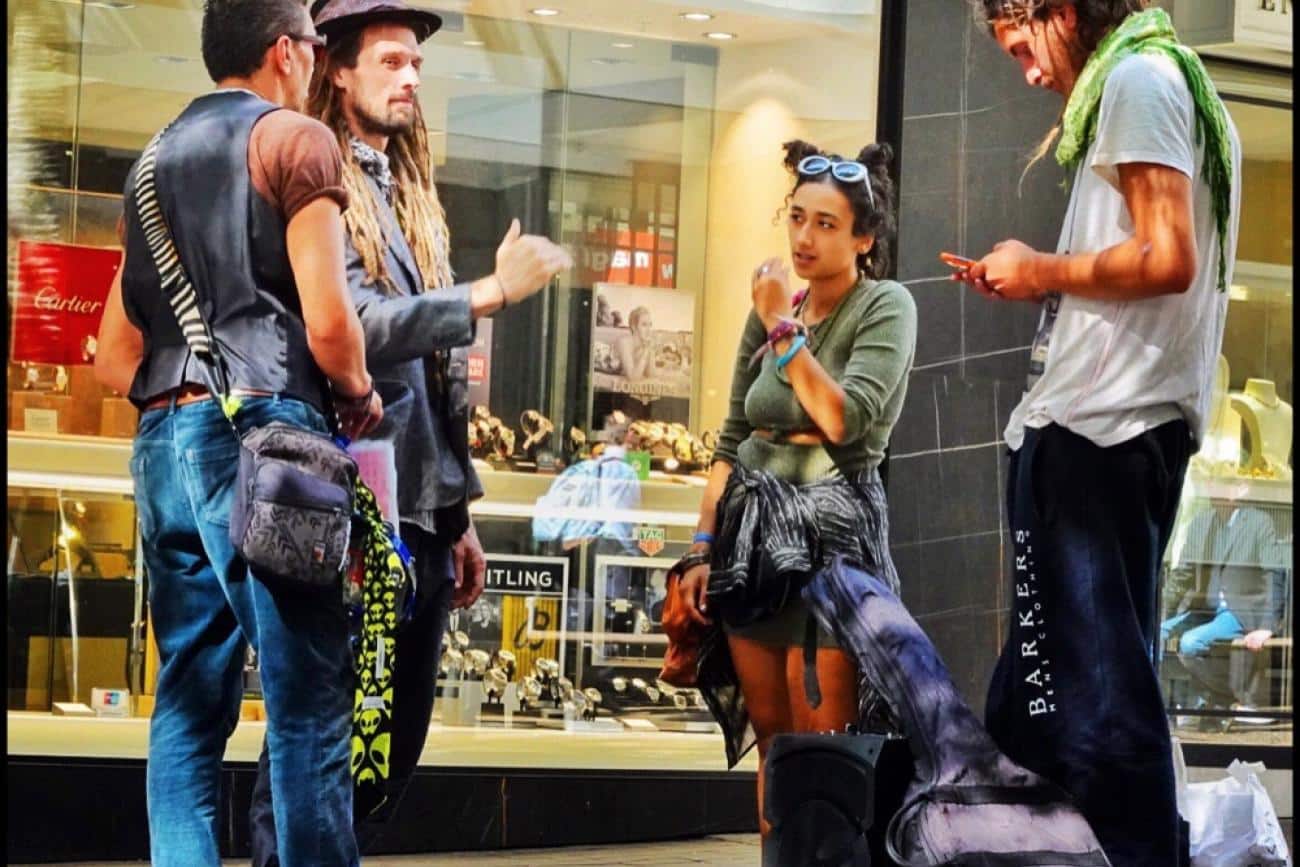
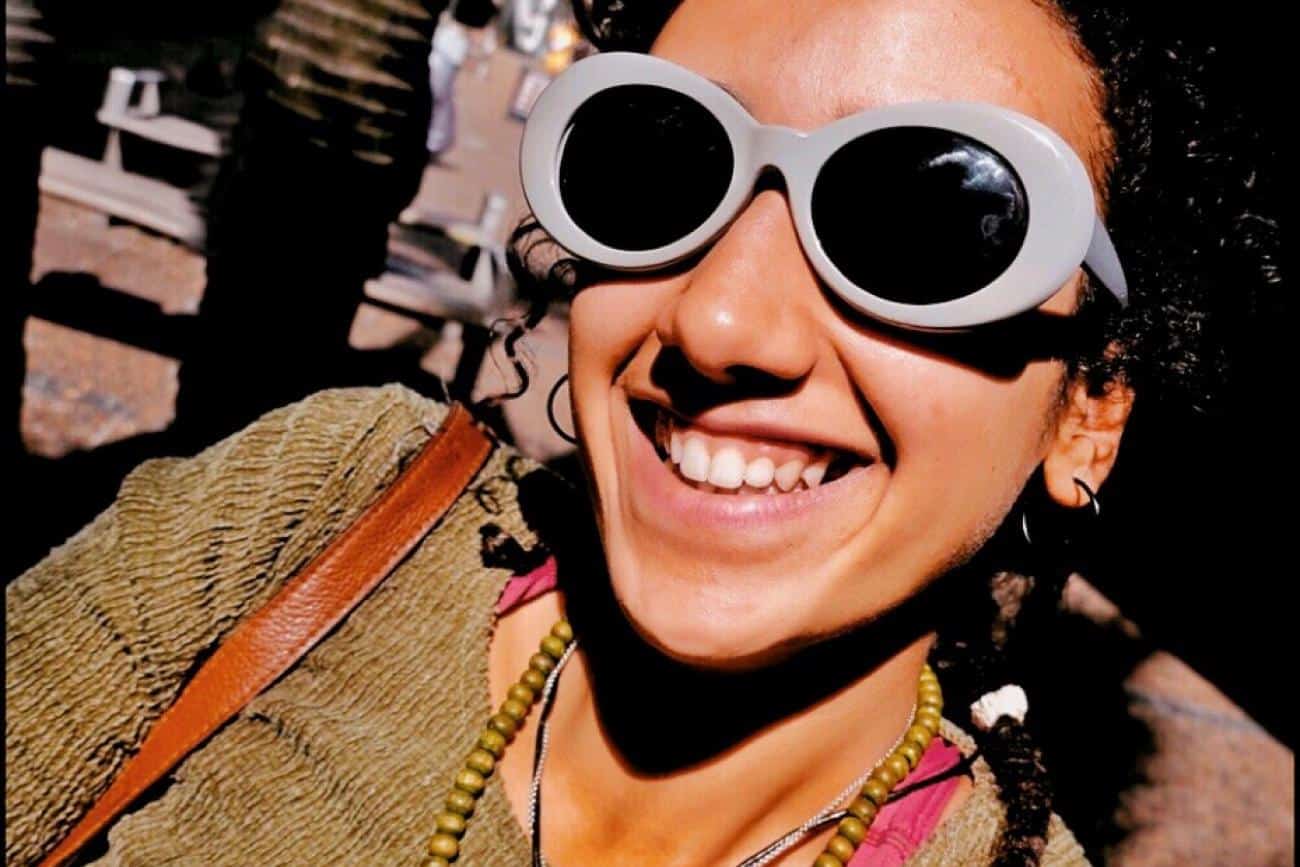
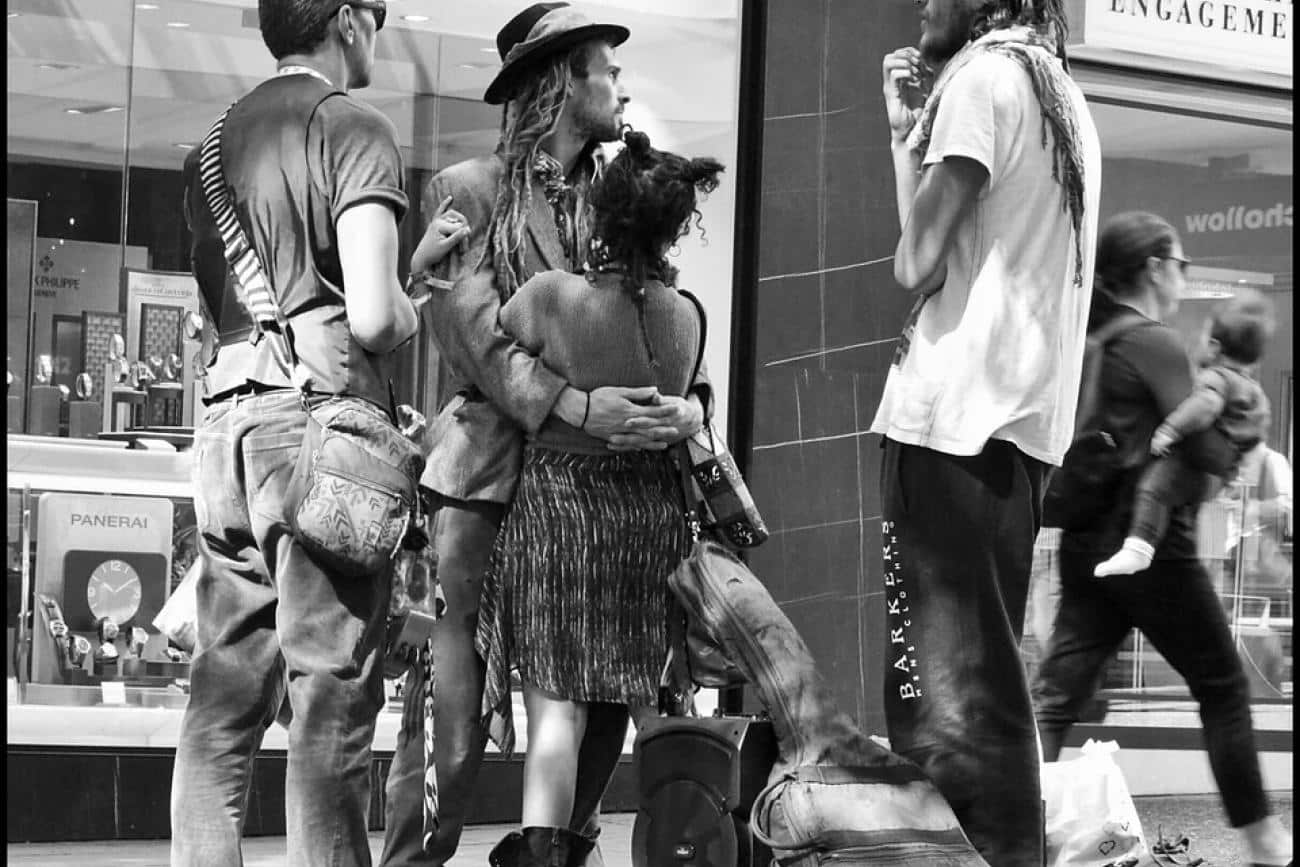
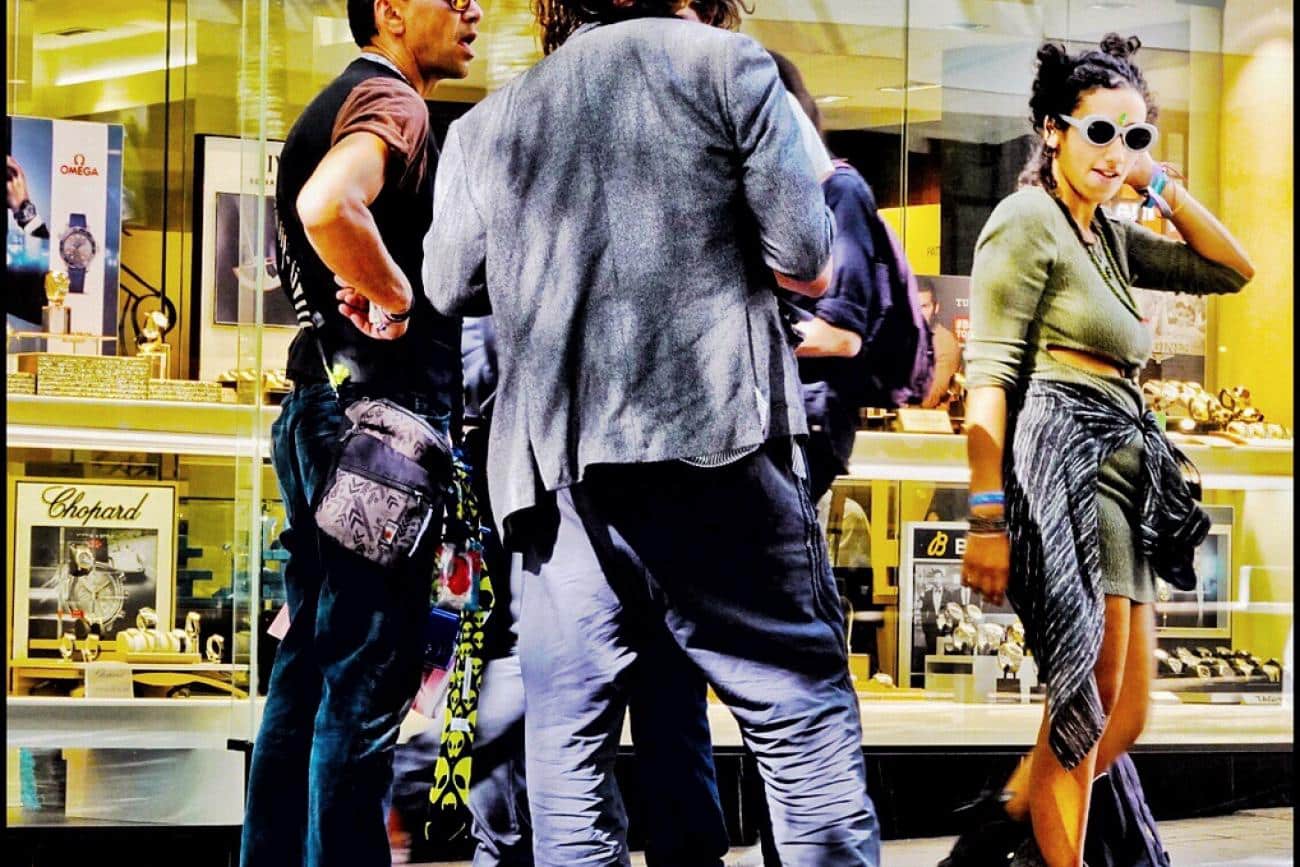
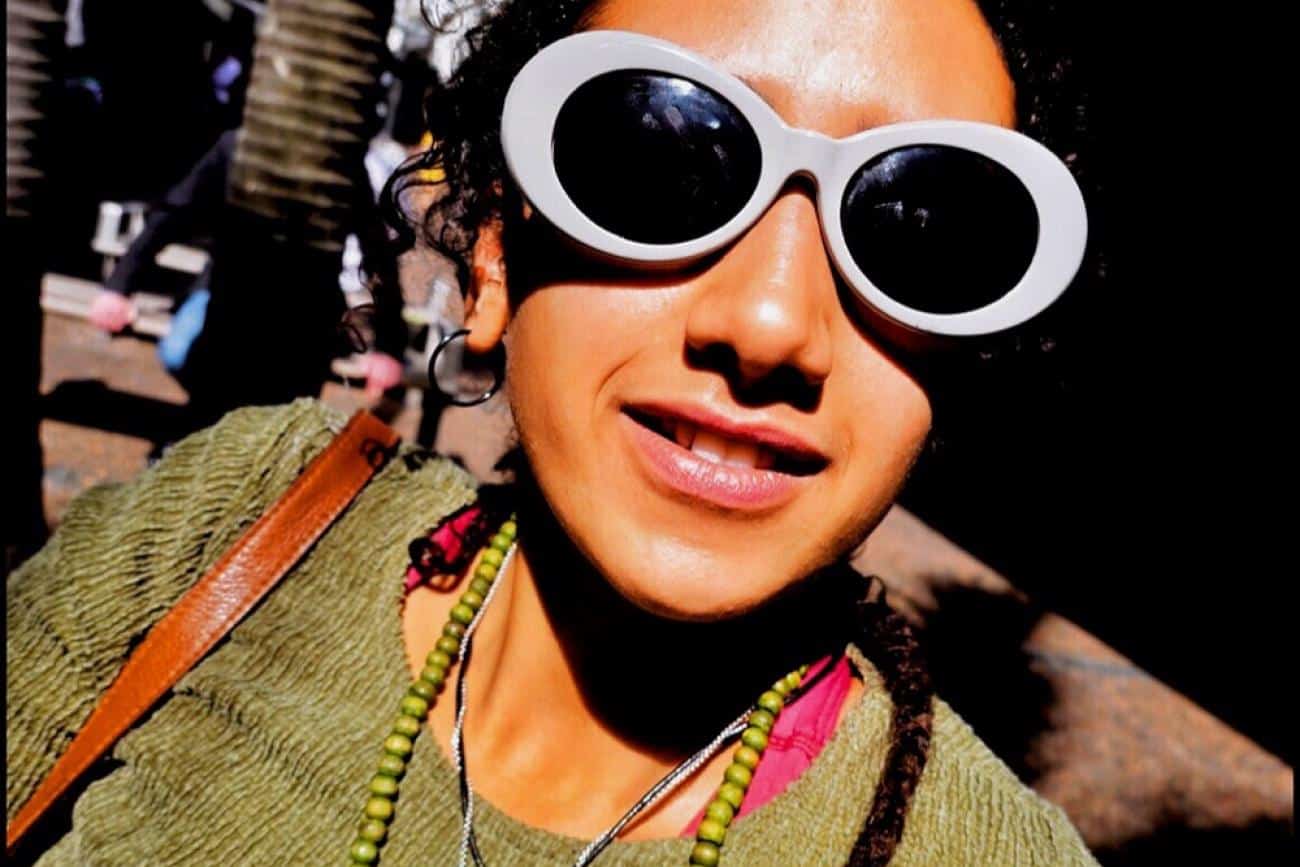
Andrew: Yes.
Charles: In Auckland, there’s Queen Street, it has all the retail shops?
Andrew: That’s right, the main street.
Charles: It was rather long, it starts close to the harbor and went way up the hill. I knew that would be an interesting place to go and do some street photography. This group had broken down their camp, they were sitting on a sidewalk there. And they must have been playing but I missed them. But they were still standing there talking and putting their gear back together. And I sat down on the bench, you know, maybe a few feet away from them. They didn’t seem to pay much attention to me. And I must have taken about 50 shots. The woman was my primary focus. She seemed to be the center of the activity. One of the gentlemen I think was her boyfriend.
But I thought the way their clothes were, their conversation, the beautiful jewelry store behind them, the colors, it was coming out really good. And so I just sat down on a bench of course people were walking in front of me. So I had to wait and take some pretty good pictures. And then when they started to disperse, she went over and sat a bench across from me. So I went over to her and introduced myself trying to convince her I wasn’t a stalker. And I said, “I took quite a few pictures of you and your friends. I found you guys as a group very interesting.”
And I showed her my camera so she could see them. She told me that she was from Spain. She loved my pictures. And we exchanged email addresses. And when I got back a few days later, I was able to download the pictures and do some editing. And I sent her about maybe 15 shots to her via her email. So that was kind of interesting. I think her name was Sophie. I think it was Sophie, kind of found her interesting, and the group as a whole they were doing some pretty interesting things to take pictures with. This was one of my favorite pictures.
Andrew: Yeah, that’s the great thing about Auckland, it’s very colourful with people. Did you hear back from her?
Charles: No, no. I kind of get used to that. A lot of people say they interested, I’ll email them pictures. I did have some technical difficulties one of the hotels that we were staying at the Wi-Fi was very slow. Auckland was great. But we had moved on from Auckland. And so I told her, she had to wait a couple of days more. And she acknowledged that she received my email. When I sent her the pictures, I didn’t hear anything back from right. We sometimes don’t expect to hear back from people.
Andrew: You probably need to follow her on Twitter or Instagram to get a response.
Charles: Yeah, I probably do.
Andrew: Right, great. Thank you. So before you came out to New Zealand, is there anything you can tell us about how you got ready for the trip you know, from a photography perspective?
Charles: Well, it wasn’t very hard for me, because I’d already been traveling for two years across the United States in a car. So I pretty much knew what camera I wanted to bring. I brought my iPad, my iPhone and that was pretty much it. I don’t shoot with a tripod very rarely. I have a Sony RX100 VI camera that’s very small. It’s a little bit bigger than a cell phone. It takes wonderful pictures. It’s highly rated. I did a lot of research on it. In fact, this version, the VI, I started out with a III and I’ve kept upgrading every time they upgrade. Because it’s really a great camera. For someone that wants to take professional grade pictures and doesn’t wanna lug around a big camera.
So when I started traveling three years ago, it was great for me, I take my big camera, a lot of my camera gear my tripod, throw that in the trunk of the car. But when I wanted to go out in like when I spent a week in Las Vegas, I can carry this camera with me. The pictures download very fast at night onto my iPad. I can edit with my apps, and then send out emails and post to Facebook that evening or late that evening usually. So it’s a great camera and I’ve really enjoyed working with it.
But I would walk around a lot of times with a strap around my wrist and always have my camera ready to take a picture. And if I was you know, doing something, I could put it in my back pocket it would fit in the back pocket of my jeans or my front pocket. Of course, I carry a backpack which would have my phone, my book, my maps so I wouldn’t get lost and my iPad. So a lot of times if I stopped and had a coffee break, or a lunch break I can look at my pictures on my camera and then if I wanted to I could download some of them when I was taking a break.
Andrew: Okay, so you’re…
Charles: I travel very lightly when it came to photography. Because with my apps and editing some of my photos, I was always kind of pleased with the end result. Which is the goal of me sharing my pictures the end result. So that was helpful to me just to be able to travel lightly.
Andrew: So that camera…could you tell us the name of that camera again?
Charles: It’s a Sony RX100 VI. Roman numeral VI. I’m holding this up I don’t know if you can see this.
Chaz’s Camera – Sony RX100 VI
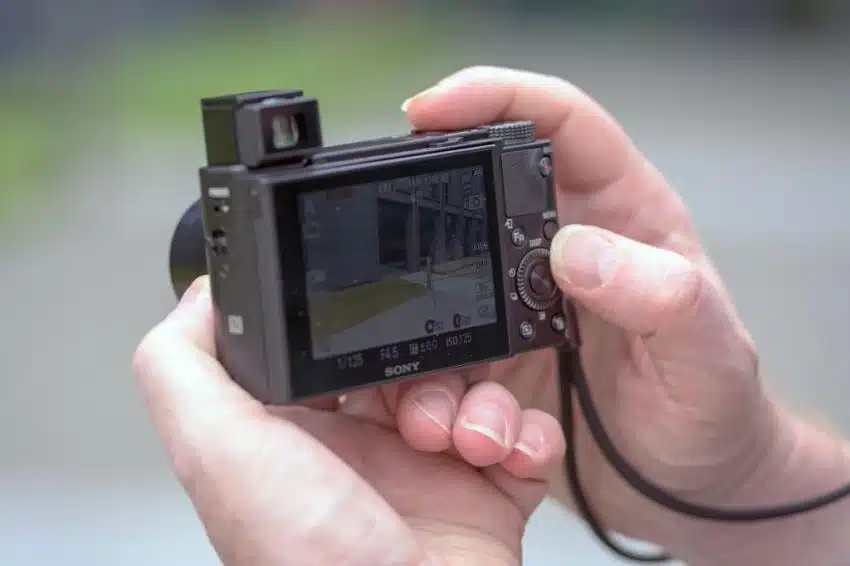
Andrew: I actually can’t, your video is frozen I can’t see you but it’s…
Charles: It’s a very small camera. It’s about the size… it’s a little bit smaller than an iPhone. And it’s a little bit thicker. It’s about twice the thickness as the iPhone. It zooms and it takes excellent pictures.
Andrew: Oh, there we go. Now, that’s better. Now I can see you now. Can you hold that… Oh, so it’s very… I see. It’s very compact. I mean, that’s the great thing of… I remember first taking photos in the outdoors kind of 10 years ago, and having this big brick around my neck. Okay, so that’s… And so basically that’s your main camera and you’ve got you said your iPad. Did you have to carry any spare memory chips or anything like that or?
Charles: If you’re downloading every day, it’s not a problem. But I don’t erase too many pictures. I kept all my pictures on the memory stick. And I bought an extra larger capacity memory stick, and I have backups. I usually carry about three batteries with me. Sometimes I can go through three batteries in one day and recharge at night. So I have all my equipment laid out, all plugged into where they need to be plugged in every night.
Andrew: Yeah. Okay, so, that’s a good tip. So you’re traveling light, you’ve got spare batteries, you may have a spare memory card. Are any other advice, you’d give to an amateur photographer, planning to visit New Zealand who wants to take a lot of photographs?
Charles: Well, I think you need to find something that is interest to you. Like people find what they call their niche. I have a friend who’s a professional photographer, he’s followed my work over the years. It hasn’t been until recently he says that I’ve become a photographer, which I thought was a good compliment. He says, “You found something that is reflected in your photos.” He said, “You found your niche, or you found your passion.” So I hope when people look at my photography they kind of get that feeling.
I met a lady that was on our tour she was on the second half of our tour and she also was a photographer. And she carried… I think she had three cameras and a tripod. And I was trying to get her to tell me really what kind of photography she took. And kind of got she was a little bit reluctant to let me know exactly what she liked. So I don’t think I had that problem I pretty much tell people what I like to take pictures of.
And I don’t try to pigeonhole myself into one aspect. But I know some things I don’t think I’m very good at. Like I wouldn’t do wedding photography. But I have gone to weddings and done what they call B-roll extra shots that the bride and groom might find interesting that the professional photographer is not taking.
Andrew: Right. So you’ve explained about the camera and the gear that you bought. Was there anything that you didn’t bring that you wish you had? Or was there anything that you did bring but didn’t need from your photography gear?
Charles: No, I don’t think so. I had pretty much what I wanted to do. Now since when I’ve gotten back to the States, I went out bought myself another Sony camera, that gives me a little bit more flexibility because it has interchangeable lenses. So I thought my next road trip in the United States I would take that camera also and take my RX100. But I think if I was traveling back to New Zealand, I would still travel with my iPad, my iPhone, and my RX100. Because like I said before, not to repeat myself, I was happy with the end result.
My pictures, I think are not always technically correct. They’re not always the sharpest pictures. But hopefully, they convey something that that you don’t see sometimes when you see someone who’s a professional photographer who gets paid.
Andrew: They certainly did. And so did you take any photographs at all with your iPhone just out of interest?
Charles: Maybe just a few. When we’re on the bus, a lot of my bus mates had small cameras and everyone was taking pictures with their iPhones or whatever phone they had with them. So I thought it was kind of interesting. Occasionally they would take a picture through the window. But most of the time I had my camera in my hand, or in my lap. So my thing was, when we made a stop and say it was a little lunch stop and everybody was rushing off to go find a place to eat lunch. You’re familiar with that. I would skip lunch and go look for a place to do photography.
And I had quite a few people that were with me traveling with me and with our tour group said that they saw things in my pictures that they didn’t see. And I said yeah, you were eating lunch, I’m out looking for things to take pictures of.
Andrew: Yeah, you know, like that empty swimming pool, in Kaikoura. That caught my eye.
Chaz’s favourite Kaikoura photo – the Condemned Swimming Pool
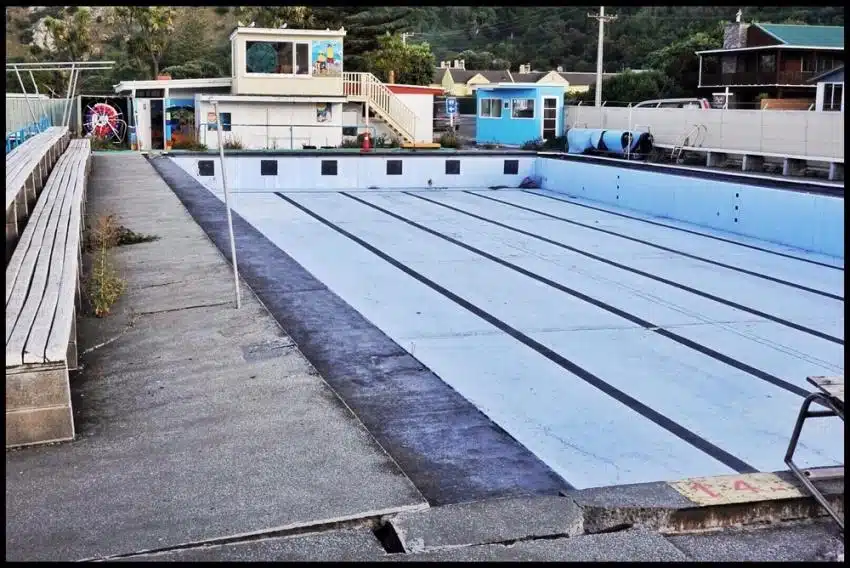
Charles: I thought it would be interesting because it was, you know, earthquake damage. Right there where a major earthquake had happened and it was quite evident from walking from the hotel, down the street. And I walked a couple of miles, in fact, even talked to a gentleman who owned a small hotel there. I think he thought I was trespassing but I asked him if I could take some pictures. He said that was his hotel, it was converted into condos. But he couldn’t… was declared… What do they call that?
Andrew: Condemned.
Charles: So just by me walking down the street, I was able to talk to someone who had been there during the earthquake, was able to share with me what it had done to their town. And they had to close off all the major roads in and out of town were blocked. And it was very interesting to talk to him, which his hotel, in fact, was almost right across the street from that public swimming pool.
Andrew: Yes, I know the place, yeah.
Charles: They had major cracks.
Andrew: Yes. Same thing happened in Christchurch after that earthquake, all the swimming pools in town, all the school’s pools were closed. That’s the backstory, of most things that you don’t realize. So can you tell us a bit about like your routine for taking photographs while you are on the tour? So like you mentioned before about skipping lunch, walking around. Was there anything you did like, you know, early in the mornings, or in the evenings? You know, from the accommodations, etc? How did you go about… what was your MI, if you had one? MO.
Charles: You know, I wasn’t getting too much rest but I wasn’t one to say well, I just gotta get up early morning to get the sunrise. I never skipped breakfast. So whenever breakfast was, I was usually there early. And then I would wander around a little bit until Paul told us what time it was we’re supposed to board the bus. And I knew from the itinerary, what we were gonna do that day. So I think it was important to dress properly you know, the correct shoes. And I always had my backpack filled with extra water and snacks. If I did skip lunch, so I didn’t starve myself, with my camera.
And I always check my camera make sure it was clean. And I had the batteries all charged. And of course every day or every two days, you’re packing and unpacking in your hotel room, so you had to be sure you didn’t leave anything behind. And then, of course, we rotated seats on the bus. So it was always nice to be able to have good conversations with your travel mates. That was a big part of the day and sometimes eat breakfast with whoever it was the early risers with me. So that was pretty much the way I planned my day was just make sure I had everything with me, and everything was in working order.
And the big thing was checking my emails if they had good Wi-Fi at the hotel. In most cases, we did. Because of the difference in hours, the time difference east coast, United States, and Auckland I had to wait sometimes to get replies back.
Andrew: Of course.
Charles: People that were on Facebook or my son via email because he would usually send emails from his work.
Andrew: Do you remember any of the like, for example, going out from any of the hotels like the couple I’m thinking of in particular. Well, there’s Mount Cook of course, you’re right there in the middle of the mountains. You know, Punakaiki the very last stop on the beach. Kaikoura’s another one, Tongariro. Were there any, you know, photos or any kind of little excursions you took from there that resulted in some memorable photos for you?
Charles: Yes, obviously being aware of where we were, I had done in fact, a little email about this. I had taken the itinerary and marked both in my book and then my map, every place that we were staying. Because I was interested in how we were getting there, how the bus was traveling, and what part of the country we were. We were on the West Coast, East Coast where all these hotels were. I did a lot of googling of the hotels and actually went to their websites and looked at some of their photos.
So where we were going to be staying, were we on the water, which is important. The place I can’t remember the name where we stayed at a hotel, it was like on a peninsula. I took a great picture from the air. It’s where the treaty was signed.
Andrew: Yes, Waitangi Bay of Islands.
Chaz’s favourite Bay of Islands photo – Waitangi from the air
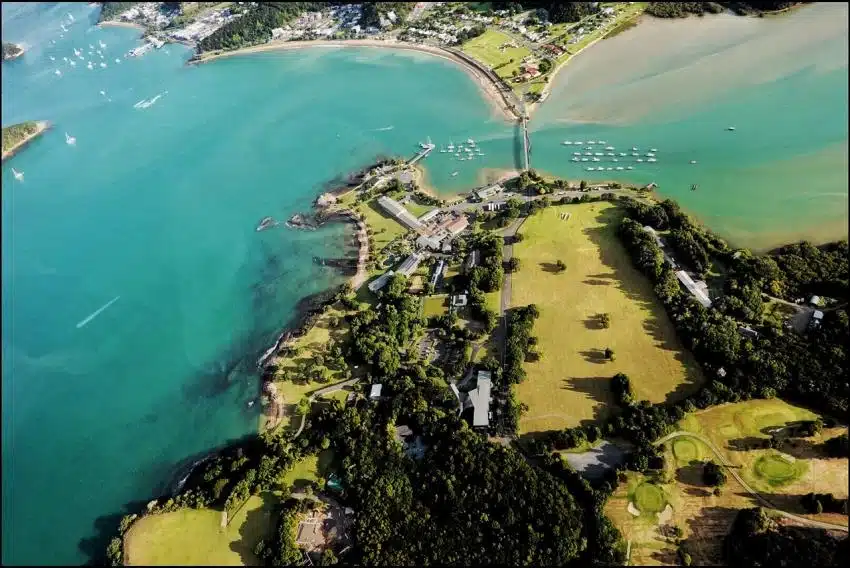
Charles: And it was a little town we went into.
Andrew: Paihia, in the Bay of Islands.
Charles: Where we went on the Thousand Island boat tour. We came back. Well, I was fascinated by that little port. So when we came back, I decided to have dinner there at that port from a nice restaurant. Got my camera out and it was getting dark. And it was maybe two miles back to the…?
Andrew: About right, yeah.
Charles: And it was…the highway was kind of looping around the bay there. It was getting dark and you actually had to kind of walk across a very narrow wooden bridge for cars.
Andrew: I know exactly which part.
Charles: Getting nice and dark. So I was getting some interesting pictures of the boats in the reflection off the water. And I told some people yesterday, they said, “What did you do for dinner?” I said, “I stayed in town, ate at this nice restaurant. In fact, I’m going back there again tonight.” And they said well, they had a shuttle that ran and dropped people off but then the hotel had a shuttle. They said, “How did you get back?” And I said walked. They said, “You walked back? I said, “Well yeah.” I said I was looking for interesting things to do, and things to take pictures of. And so it was kind of fun to do that. I had to turn my iPhone on to use the flashlight because it was getting too dark coming across the parking lot. I couldn’t see.
Andrew: I don’t know if I’ve seen any of those dusk photos.
Charles: I think I have one, I’m not sure if it made it to the cut.
Andrew: And how about kind of landscape kind of scenery? You know, obviously places like Mount Cook, and obviously Milford Sound. How did you go there with your camera?
Charles: The only problem sometimes I had with the tour was obviously we’re on a tour, there’s 18 of us at most, sometimes a little bit less. But you know how that works. And we’re going someplace and we’re not there for too awfully long of the time. We went to Milford Sound we took one of the boats out and came back. And we took an airplane back, short trip back to Queensland which was nice.
Andrew: Queenstown.
Scroll through Chaz’s Milford Sound photos
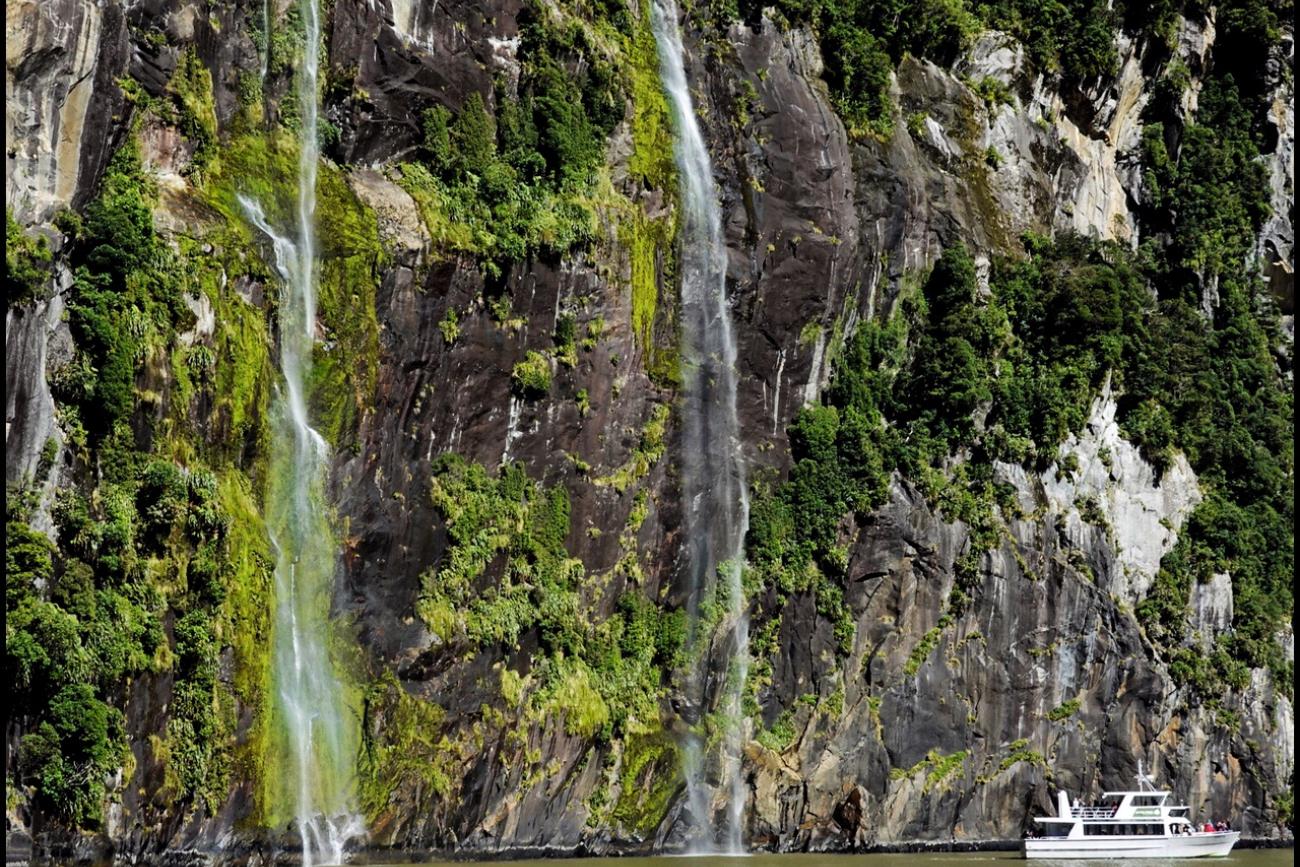
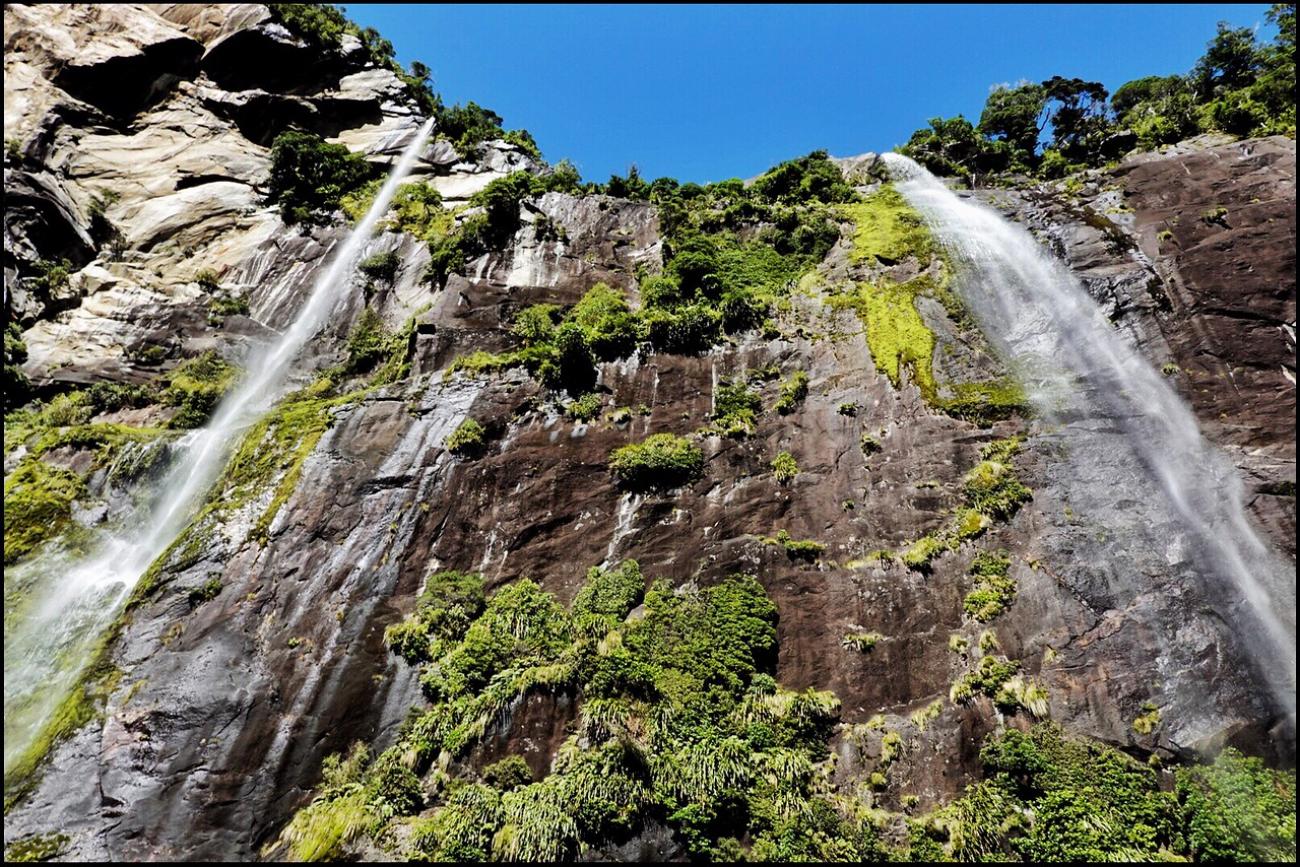
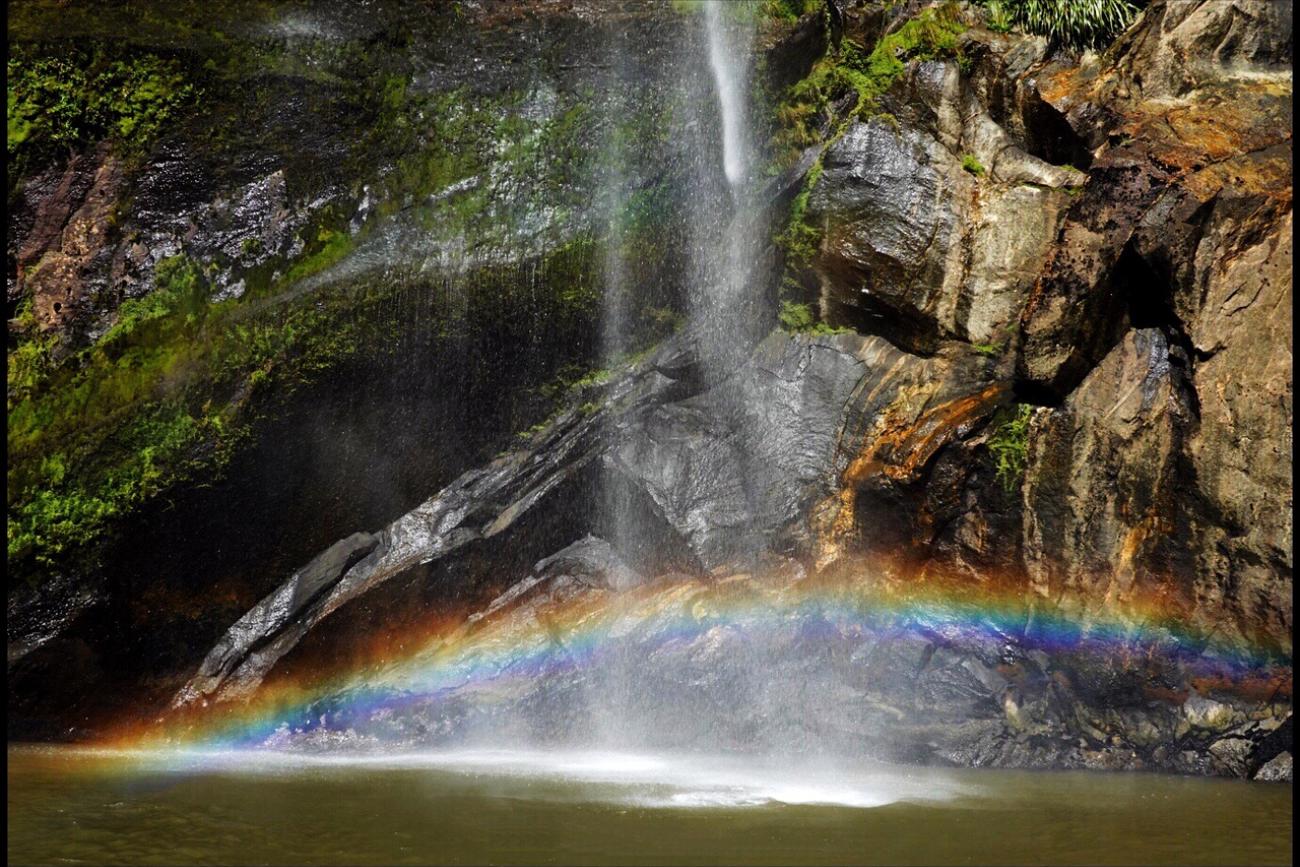
Charles: Yeah, Queenstown. But when you wanna take photos of landscapes, you don’t have really much time that’s set up. A lot of people like to carry a tripod set up, wait for the right lighting early in the morning or late at evening, what they call the blue hour or the golden hour. We’re on a tour and it’s high noon, you take the picture, you hope it comes out. But a lot of times, it’s not the most ideal conditions.
So if you had a professional photographer, more than likely he wouldn’t go on a tour. He would go on his own or hire a guide and say, “Okay, I’m gonna go here. I wanna take this picture at sunset. And I’m gonna camp out here all day and come back the next day, or the next day, or the next day, or the next day depending on the clouds, the sun, the skies, all those things that go to take a good landscape photo.”
So you just gotta take what you take and hope it comes out good and make the best of it. Sometimes I wish I had a little bit more time. I’m kind of quick photographer, I don’t take a lot of time. I see something I like I kind of set up a little bit take the picture move on. But sometimes you wanna spend a little bit more time. Not having constraints of the tour, or being part of the herd and everyone trying to get back on the bus at a certain time.
Andrew: We don’t call them herds, goodness me, [inaudible 00:43:16] tours. How about in places like, as I said before, Mount Cook or Wanaka or Punakaiki? Because those are places where we actually do spend one or two nights there. Did you get anything? How did you go in those spots?
Charles: I think I did pretty good. Because I was able to scout out the area. And I think there was one place where they had the hot springs and the hotel was pretty close downtown. Had some beautiful parks and the springs are hot.
Andrew: Rotorua may be or Franz Josef? Rotorua probably.
Charles: There’s a beautiful church there.
Andrew: Oh, yes, Rotorua. Yes.
Charles: People were telling me about how beautiful this church was.
Andrew: I know the one, yeah.
St Faith’s Church in Rotorua
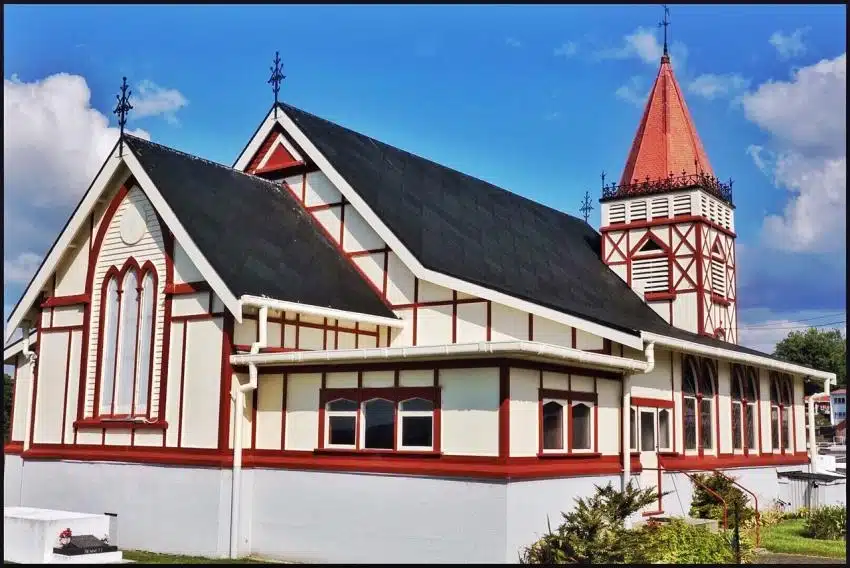
Charles: I made a point to walk down to the church, walk back around it to the springs and then meet up with some of my travel mates for dinner. So I always kind of had an agenda. If we were at a place more than one night you know, what’s the group doing a lot of time because we went down to dinner together. And trying to work in a couple of places where I could take a couple of photos. I like art. I think you see a lot of pictures of buildings. I find architecture and mosaic fascinating.
Andrew: And so how would you sum up… You know, from the perspective of someone wanting to take lots of photographs, how would you sum up your experience on the tour, on the MoaTrek tour?
Charles: Well, I think if you counted the number of photos I took and posted on my website, those are the ones I liked, was close to 900 photos. Because it’s obvious that I take a lot of photos. And I must have found the time to do that, to take all those photos. And so I had to…you have to pace yourself, you gotta take a timeout every once in a while. You gotta put the camera down, you gotta say, “I gotta enjoy this.” Especially when we were on some of the tours which I thought were very educational, and interesting.
Some of the buildings and through some of the areas that we went to, there was a time to put the camera away and just enjoy myself. And still, I took a lot of pictures because I’m constantly taking pictures of things. And I think with the extra days I booked both prior and after my tour, the optional days, I did book a couple of options, which I enjoyed doing. But then I kind of said, “Well, this, is going to be my free time to explore a little bit more in some of the areas.” And I think Paul did an excellent job when we went into a town and he said, “Okay, here’s our hotel,” he would just drive us around for maybe 10 or 15 minutes.
He said he’s gonna point out a few things for us, maybe where some of the restaurants were, sometimes he would drop us off at a grocery store for those people who wanted to eat in. Which was nice for those people who didn’t wanna go out to dinner every night or wanted a bottle of wine to sit around the pool at night and share a bottle of wine with your friends. So we did a lot of that. So when he drove around, he kind of pointed out some of the highlights that were close to the hotel where we were staying.
So if I didn’t already know about it already, from looking at my tour guide book or doing the research on the internet, it was nice just to know, for me, because I walked everywhere what my walking paths was gonna be like, and what the area was like, so I thought that was kind of interesting.
Andrew: Yeah. And would you recommend a MoaTrek trip to a friend who loved photography?
Charles: Of course, I would. I don’t see why…anyone that’s interested in photography, and wanted to go somewhere interesting to take pictures, New Zealand would have to be the first place I would recommend someone to go. I don’t particularly like going to places where people had been before and take the same pictures, or same tours take pictures of the same tourist sites. And I didn’t get that feeling when I was in New Zealand. A lot of interesting sites, a lot of interesting things to take pictures of.
But I didn’t feel like I was following in the footsteps of some other tourists who’ve been there six months before me. Because I looked at all your pictures on your website. Some of them were very nice pictures. But I didn’t feel that I’d be following in someone else’s footsteps and taking the same pictures. It’s the worst thing a photographer can do is say, “Well, I like this picture of the Eiffel Tower. I’m gonna go to Paris and take the same picture.” You know, no one wants to even see that.
Andrew: Yeah. And I guess the thing that struck me is that you know, you’re on that itinerary with the group, but you just take a few steps off, and just make a little bit of time and you can really almost see the different perspective. And that’s what all of us, you know, we’re really taken with… You know, like I said, we’ve seen thousands of photographs on that trip. But it’s just, you know, basically, to a photographer, you know, since you can just go off a little bit on your own, make your own time, but within the constraints of the tour and then end up with something completely different from a photography perspective. How does that sum it up, you would agree with that?
Charles: That’s great. That’s what hopefully my photography shows that I like to do.
Andrew: Now, is there anything…from a general perspective, do you have any favorite or tools that you use either apps or online tools for photography that you think other travel photographers may be interested in?
Charles: Well, I use a…you have to be able to edit your photos. And so I edit all my photos on my iPad Pro, which isn’t the biggest iPad that you can buy. And I have a couple of apps ones called Snapseed.
Andrew: Snapseed.
Charles: And one called Color Story. Of course, then I use a map that I post my photos on called SmugMug. And that’s a photo website that you can set up your own website to display your pictures and put them in galleries.
Andrew: Yes, I’m looking at your website now. And we’ll put the link on the page through to your website so people can take a look…
Charles: You see a number of different galleries there sometimes I have to trim them back a little bit. If you go to the page that says ‘wall’ my wife and I when we were married…we were married for 18 years. And, of course, she encouraged my photography and got to the point where I was printing some of my pictures and putting them in our den. And so we moved from one house to another house. And so she said, “You know, I like your photography, but can we just kind of limit it to this one wall in the den so that doesn’t get scattered all over the house?” You know, keep your wife happy I said yes.
So it always became my wall. And then her and I would discuss after I had a shot that I took and had it printed up and framed whether or not it was wall-worthy. So when I set up my website, these are my favorite pictures, I can put them on the wall because now I don’t have a condo any longer I live in an apartment, so I can get all the pictures I want to. But that’s my wall and those are my favorite pictures.
Andrew: Yeah, more people can see it. I guess if you google ‘Chaz Anderson’ photos, it will probably come up. And we’ve got a couple of your galleries on our website. You could just probably google ‘MoaTrek Chaz Anderson’ or something like that and they will come up. But we’ll definitely put some links on the page here. Because I know, photographers are always looking for, you know, the handy apps to make their travel, you know, especially when you’re traveling but you know, you’re constrained a bit if you’re taking photos from your home base. So those apps you’ve mentioned. Anything else or any other just magic tips that you think someone coming to New Zealand would appreciate?
Charles: Well, I enjoy posting pictures to Google Maps. I have over 2,300 photos posted to Google Maps that have 11 million views.
Andrew: Whoa.
Charles: Eleven million. So what I do is if I go to a restaurant or I go to an area, I will take some pictures [crosstalk 00:52:19] to Google Maps. And then I usually write a review. And then I’m interested in seeing how many hits I get sometimes or how many people view my photos. And usually, you get comments back from the people that own the restaurant. or the antique shop. And it’s always kind of fun to do that.
So I kind of like to do that as a hobby and carry my camera with me all the time. So I loved Google Maps, it’s great place to look up things obviously. I love my SmugMug account. I have a love-hate relationship with Facebook.
Andrew: Don’t we all?
Charles: I enjoy my emails with my son because he responds right away. We go back and forth sometimes, especially when he’s at work, I can tell what time it is when he’s at work. And we’ll go back and forth a couple of times, commenting back and forth about things that I’m doing. So I find that enjoyable. And my sisters are on Facebook, and my friends are on Facebook. So it’s always nice for them to see what I’m doing. And I get comments from them also. So it’s always kind of interesting. Help me keep [inaudible 00:53:35]
Andrew: Some photographs on MoaTrek’s Google listing.
Charles: Well, it’d be a little hard to download 982 pictures.
Andrew: Yeah, 900. I’m just looking now actually and I can see there’s another photographer, I don’t think she was on your trip a lady called Lois. And she’s just put up a whole bunch of photos on the MoaTrek Google… What do you call it?
Charles: Google Maps.
Andrew: Google Map, yeah it is Google Maps isn’t it? Google listing yeah. Is there anywhere in New Zealand do you remember posting, you know, a photograph to a place you visited on your tour? I’ll have a quick look and see what I can see.
Charles: I probably didn’t do too much postings on Google Maps when I was on my tour because I was too busy downloading things to Facebook and emails. I can’t think of anything right now. I think…might have been the Winter Garden I might have posted a couple of pictures there. Because I had lunch there and took some pictures inside one of the buildings there, flowers, and water. Of course, that woman walking through the Winter Gardens that was one of my best pictures I think. So I may have posted something to Winter Gardens.
Andrew: All right, I’ll have a look. Just looking now I can’t see anything coming up. They haven’t got their listing now optimized.
Charles: Also the museum in Wellington, the big museum there.
Andrew: Yeah, Te Papa.
Charles: Yeah, I think I posted some pictures to their website too.
Andrew: Let’s have a look.
Charles: That was a very interesting museum.
Andrew: Yeah, I mean, they’re gonna have a million pictures, aren’t they?
Charles: Yeah, that’s the problem. See, if you pick a site that’s very well known everyone’s posting pictures to that so it’s kind of…Google Maps just added a thing where you can see just your pictures. Pictures posted within the last day or so. So you don’t get lost in the big shuffle sometimes.
Andrew: Now what we’ll do, Chaz, is we’ll put this interview we’ll put it up on our website. Now, if there’s one photograph from your entire New Zealand trip that you could choose because I have to choose one. We’ll choose one as, you know, like the mast image, the hero image. Which photograph would you choose to represent your trip?
Charles: Now, this is not a criticism. But when you look at MoaTrek’s website…and I know you’re doing this to attract the tourists.
Andrew: Yeah.
Charles: About the beautiful countryside, and the tour, you know, those sights you go to see, which I’m sure is a big attraction. But to me, the one picture I took of Auckland is my favorite picture. Because on the flip side, where I like, may not be what your typical client likes. I like to be in the cities. And I love the countryside. So I like both. So I was attracted to your tour because you also went to some…well you went to all the major cities. Went to Auckland, Wellington, Christchurch. I enjoyed that part of the tour just as much as I did, going out and seeing all the beautiful landscape. So it was an added bonus for me.
Some people may not enjoy being in the city atmosphere but I did. And I noticed some people in our tour, they did things on their days off, bike riding and side trips like I did to museums. So I think they liked it. But I don’t think you guys promoted it enough and maybe you should.
Andrew: Okay, well you’re the artist, Chaz. So where you will put that image front and center don’t worry. We can take that criticism, we like our cities too, you know? We can take that.
Charles: But you saw the one picture I took of a gentleman that was all in white?
Andrew: Yes, yes.
Scroll through Chaz’s photos of the Street Performers in Wellington
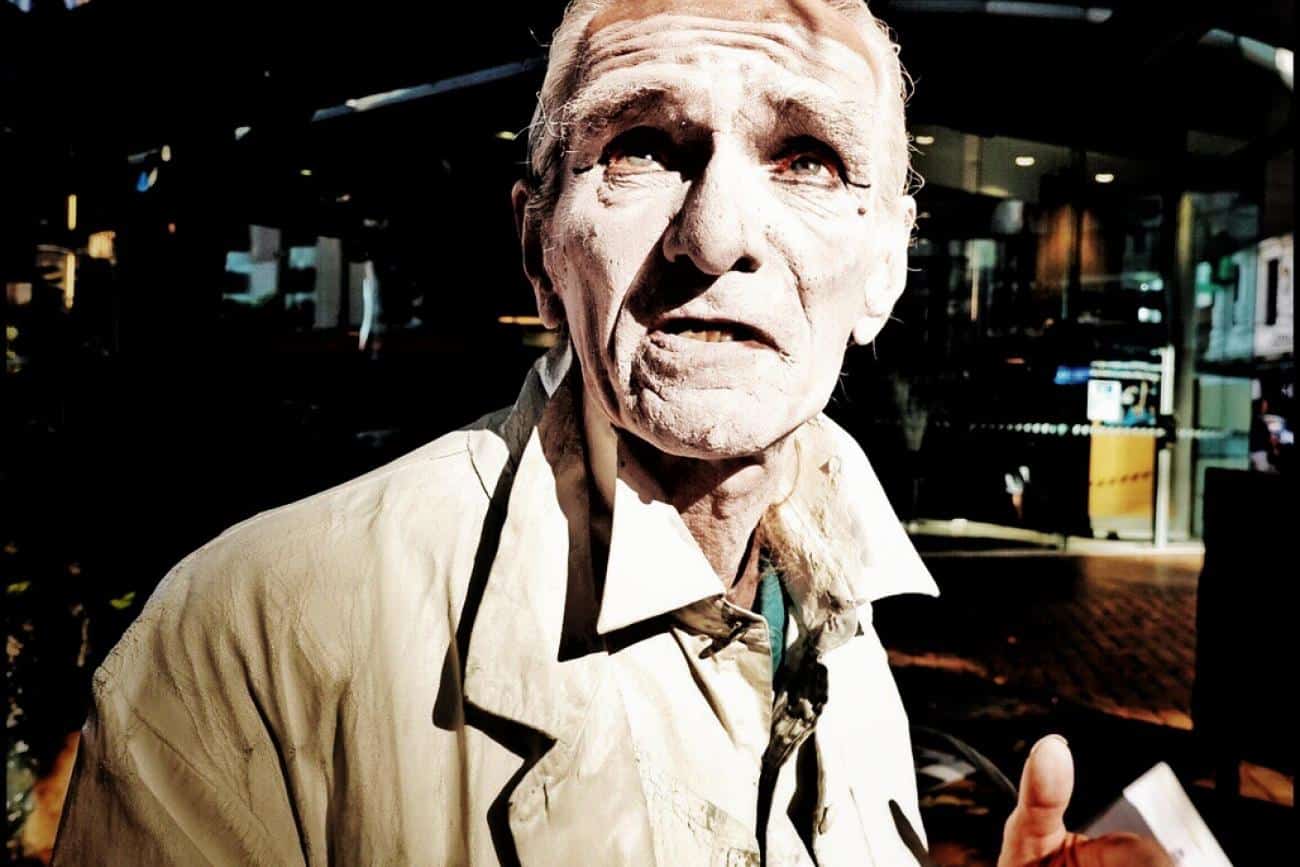
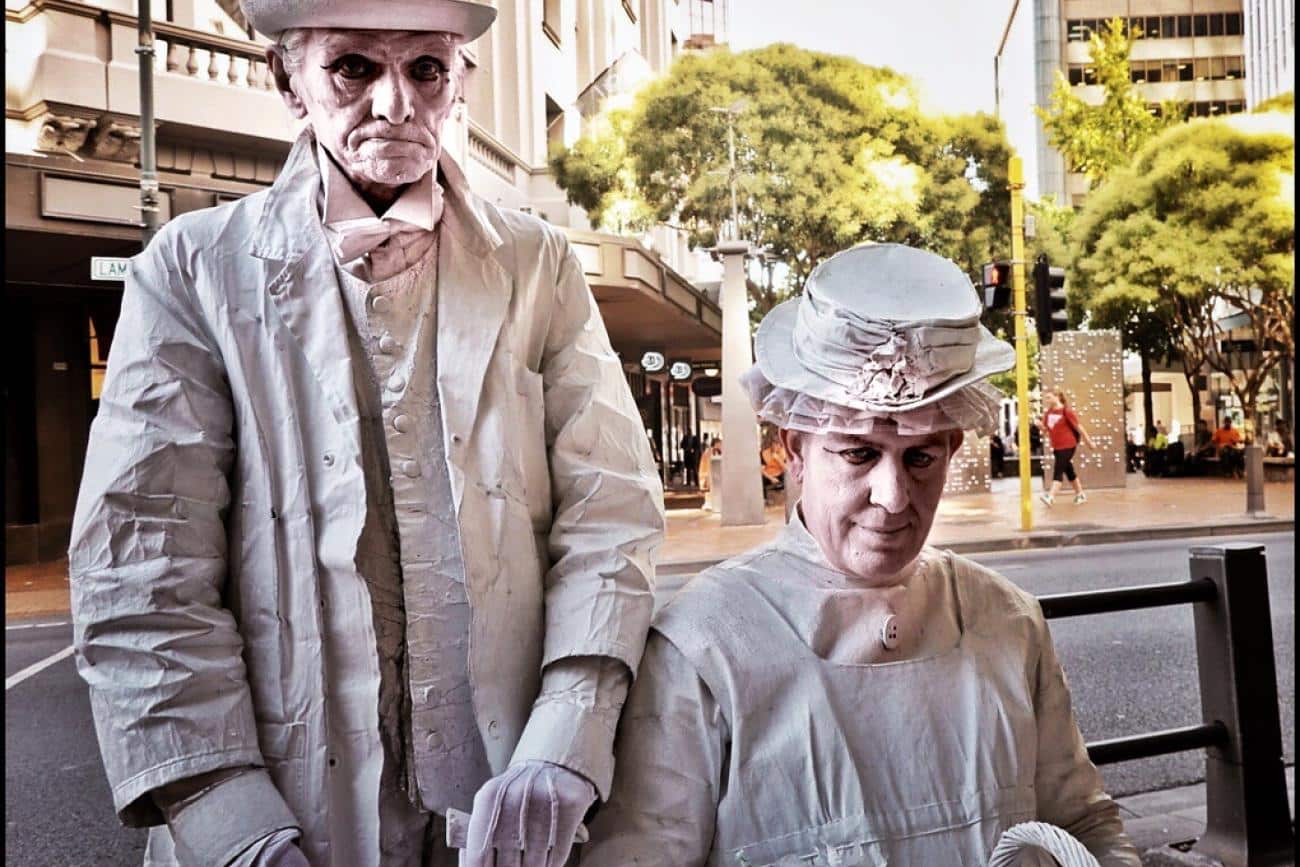
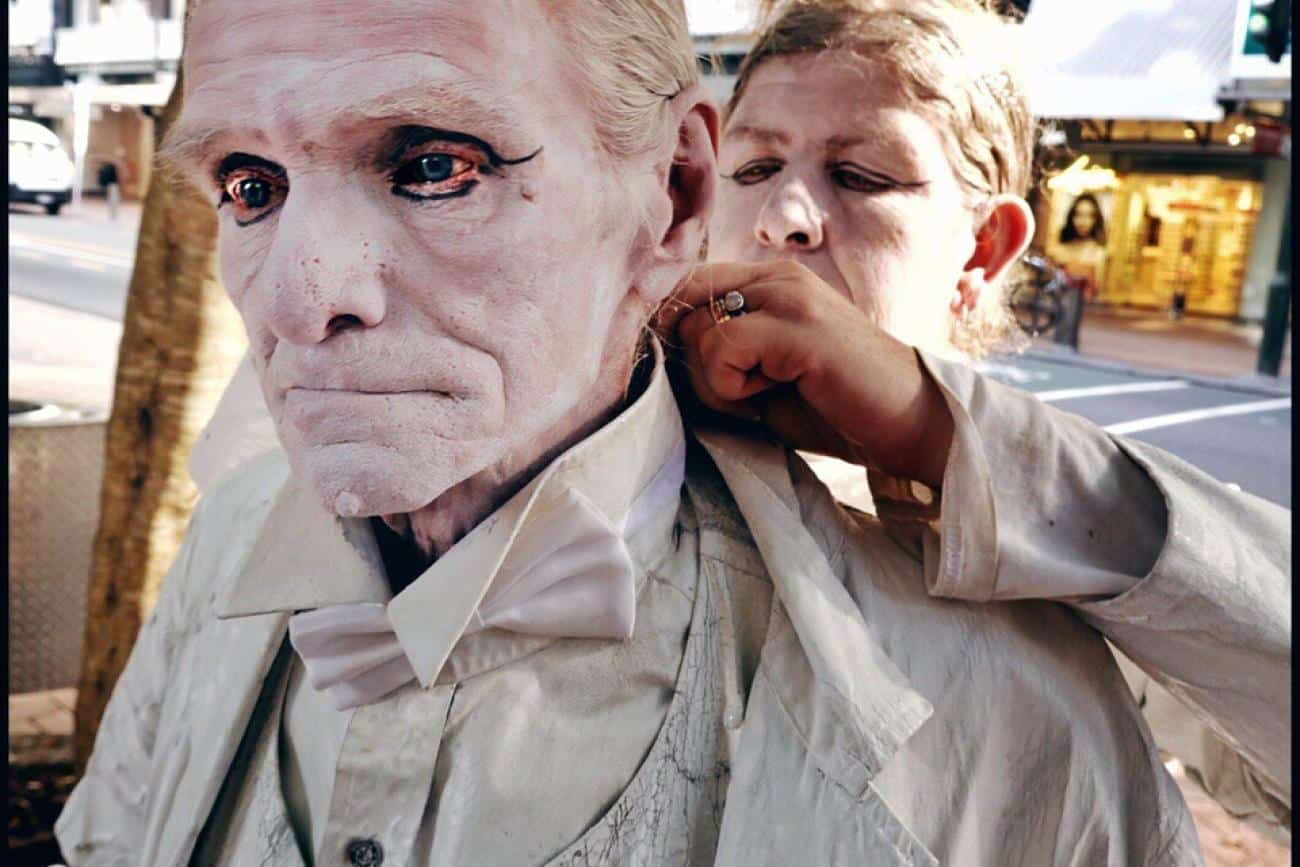
Charles: Interesting story there if you have a minute I’ll tell you the story about this guy.
Andrew: Tell us about him because you got three or four of him and his friends haven’t you?
Charles: Him and his wife. This was in Wellington, that main street there where all the retail shops are at close to the hotel. Had already gone to the beehive and was working my way back towards the harbor. I glanced over this little side road and I saw this guy who was all dressed in white and his wife, which I found out later was his wife, was putting black mascara on his eyes. I said, “Well, I’m gonna double back across the street and talk to them.” And what they were they are street performers and they were human statues.
And so I talked to him, his wife, she was too busy putting on makeup and stuff. So they had all these old clothes and he had a top hat. She was all dressed in white and she was finishing up his makeup. And so him and I had an interesting conversation about his background. I think he was an actor. He’s a business person. He actually had a business card. We exchanged business cards. But then they moved across the street and it was I guess a busy area, it was busy when they set up and got into their routine. And I walked over and they were acting like statues. not moving and people were putting money.
So I walked around. I showed him my camera. I said I’m gonna take a few more pictures. And took a few more pictures. And then he brought character he gave me the nod like he said, “Have a nice day, Charles.” So I thought that was kind of cool. Then he went back into character as frozen as a frozen . I thought that picture came out really well. Just one picture I think I sent you of him kind of glancing up.
Andrew: Yeah, well I’m looking at it right now.
Charles: Kind of wondered who this guy is and what he’s doing but he was a street performer, he was being a human statue
Andrew: Where was he from?
Charles: He was from that area, Wellington. He was from Wellington and I asked him, he said he did that three, four days a week. He had other jobs. I think he was a part-time actor. He did a little bit of everything. Him and I did most the talking, she didn’t say much. So I thought that was kind of interesting. Once I approached him and said, “Hey, what are you guys up to? Who are you? Here’s who I am, can I take a few photos?” He said, “You can take all the photos you want to.”
Andrew: Excellent. Yeah, that one certainly stands out. That one certainly stands out. Is there anything else that you’d add Charles if you had a 30-second elevator pitch to someone who wants to take photographs in New Zealand what would you say? It’s a tough one.
Charles: Well, I’ve done a lot of talk. The only thing I can say, from a standpoint of being a photographer is that it’s my desire to come back to New Zealand. I thoroughly enjoyed myself when I was in New Zealand. I thought the tour was an excellent tour. They gave me opportunities to meet people both on the tour and off the tour. It gave me a variety of different places to visit, which I enjoyed doing. In turn, that gave me quite a bit of opportunities to go off on my own and take photos of things that I enjoy taking photos of. And it’s a little bit of a hit or miss sometimes whether or not anything is gonna come out any good.
And that’s your desire as a photographer, is you capture something that someone can look at, and find some curiosity about, or enjoyment about. I mean I’ve looked at other people’s work sometimes as well, this really doesn’t do anything for me. But I’ve been really, really overwhelmed by the response that I’ve gotten from MoaTrek, yourself. People that were on my tour, and some of the emails I’ve gotten, my family, my son. It’s helped me I think, as a photographer to get a bit more confidence in what I’m doing. And of course, if you see my website I’m off in all kinds of different directions with the work that I like to do. Some of it is a little bizarre sometimes. But it’s fun.
Charles: If I could contact my ex-wife today, I would tell her, that I think all my work is wall-worthy. now.
Andrew: Wait until we publish this online and you’ve got 10 million followers and then contact her. One issue, there’s one image I remember the first image I saw of yours. And it was that image you took if you remember that homestead in Canterbury that you know, you stop in for lunch and there’s the wonderful people there Ian and Diane.
Charles: Yes.
Andrew: But the image that I saw was you had put her through some filter or some tool. We’ll put it on the page but can you tell us about that one. You know, the one I mean?
Chaz’s Photo of Akaunui Homestead in Canterbury in Pixlr
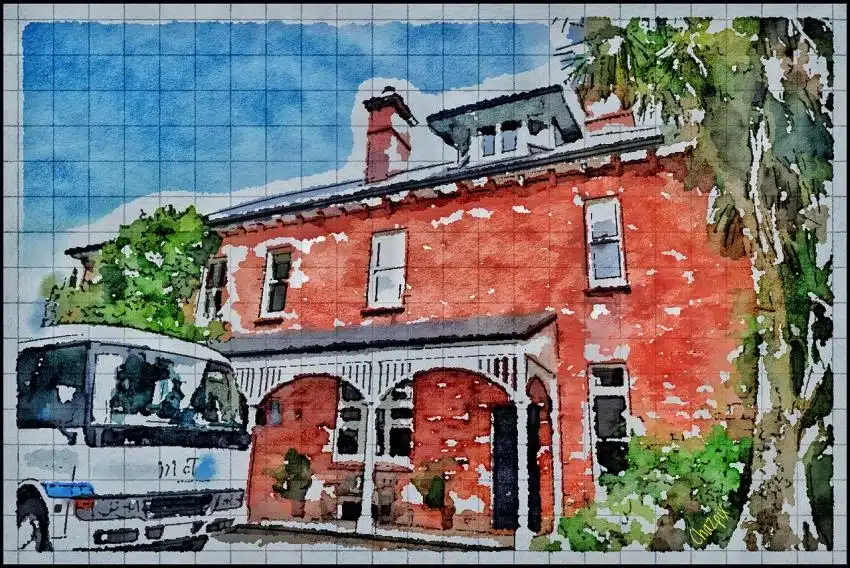
Charles: Yeah, I have an app that I use sometimes if a photograph comes out a little bit too harsh, if I didn’t have the right aperture setting, the picture comes out harsh and I really like the composition of the picture, I put it through an app I have. I think it’s called Pixlr P-I-X-L-R I think is the one I use, and it will colorize the picture. And you can pick the degree and sharpness, it’s a little app. I don’t spend too much time editing photos, but every once in a while I’ll run something through that because I thought it was interesting.
Well, I enjoyed that part of the tour. I was fascinated with our host. We had a wonderful lunch. The house was beautiful. I walked on that house and took quite a few pictures of the dogs, our guest, the beautiful gardens they had there. And when I walked around to the front of house where Paul had moved the bus, we came in on the side, we disembarked, we went out to the tables had lunch. And I think he kind of moved the bus around to the front of the house. And we were actually on the back of the house. I’m sure you’ve probably been there where the pool’s at and then there’s a little pond there. The tables were set up.
So I walked around the front house to see what was there. And of course Paul he had… the bus was parked right there and the house was right there. And I said I gotta take this picture, I’ll take a quick picture because no one was in it. We hadn’t gotten back on the bus yet. So I thought that was a pretty cool picture. So I ran through that little app and did some colorization of it a little bit. I think that came out pretty nice.
Andrew: And it was very eye-catching. And as I said that was the very first one I saw of yours. And I forget who someone emailed it to me, and I as soon as I saw it, it caught my eye. And that’s what kind of started drawing me into your photos.
Charles: Some photographers don’t like if you edit pictures too much.
Andrew: Of course, yeah.
Charles: I kind of have this balance sometimes if I like a picture a lot and I think I can edit it just a little bit to make it a little bit more interesting I do it just for fun, just I like to do it. That was one of my favorite pictures also.
Andrew: Yeah. well, thank you, Chaz. And as I said before like we all were just so taken with your photographs. I myself have looked through them all, many, many times. And I know everybody Miles and Ena and Alisha and Tanya, everyone that you spoke to, you know, got so much pleasure out of them. So, you know, thank you so much for coming and visiting us. Thank you so much for joining us on the tour. And I know that your guests, your fellow travelers would probably say thank you for the photos too because we’re seeing some people, you know, on your galleries and commenting online and stuff. So yeah, thank you. And thank you for today.
Charles: My pleasure, anytime.
Andrew: So that’s our interview with Chaz. And I hope you all enjoyed it. We certainly enjoyed…I enjoyed the chat and have really enjoyed looking at all Chaz’s photographs. And now I know even a bit more about the stories behind them, they mean even more. So that’s us. From Chaz and I, we’d like to say thanks for listening, and we’re moatrek.com, New Zealand Small Group Tours.
And MoaTrek is a family-owned New Zealand business been running tours all around New Zealand since 1971. And we’re all about discovering New Zealand, traveling around New Zealand in small friendly groups. Fully guided with our Kiwi guides, staying in nice comfortable places each night, enjoying great food and wine. Getting out enjoying the best New Zealand countryside on short walks and you know, really fun, you know, activities. And just having that real trip of a lifetime with like-minded people here in New Zealand. So to find out more, have a look on our website, it’s moatrek.com. And we hope to hear from you soon and see you down here in New Zealand soon. Cheers.
More NZ Photography Tips & Galleries
Read our Guide to Photography on Tour in New Zealand
MoaTrek Guest Photos – New Zealand by Chaz Anderson
MoaTrek Guest Photos – Te Tāngata by Chaz Anderson
New Zealand Unfiltered – Charles Anderson


